
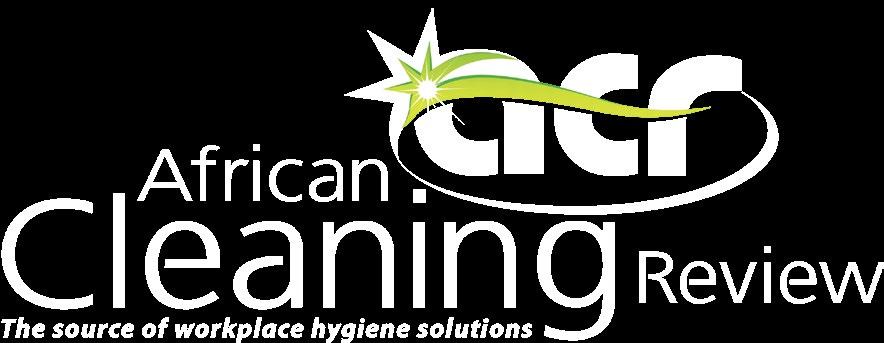
® Hygiene • Cleaning • Pest Control • Laundry • Facility Management Services November/December 2022 In this issue: Mapping indoor workplaces Hospitality cleaning solutions Retail cleaning solutions
r Absorbents – Oil/Chemicals
r Access Equipment/Ladders
r Air Cleaning Equipment/Air Duct Cleaning/Indoor Air Quality Systems r Air Filters/Air Purifiers r Air Fresheners r Anti-Stain Treatments r Baby Changing Stations r Bactericides r Barrier Creams & Cleaners r Biological & Enzyme Products r Bird Repellent r Bleaches r Blind Cleaning Equipment r Buckets/Wringers r Carpet Cleaners r Carpet Cleaning Systems r Carpet Detergents r Car Valet Products/Services r Car/Truck Wash Systems/Services r

Catering Equipment Cleaning r Catering Hygiene Products r Ceiling & Wall Cleaning Equipment r Chemical Dilution & Dispensing Systems r Chemical Raw Materials r Chewing Gum Removal r Cleaning Chemicals/Agents & Consumables r Cleaning Equipment/Cleaning Equipment Hire r Cloths & Dusters r Compactors/Compactor Bags & Tubing r Computer & Cleanroom Cleaning r Curtain Cleaning r Customised Cleaning Solutions r Descalers & Degreasers r Detergents r Dishwashers r Dishwasher Dispensing Equipment r Disinfectants & Sanitisers r Disinfection/Decontamination/Fogging/ Sanitisation Services r Dispensers/Dispensing Products r Dosing Equipment r Drain & Grease-Trap Maintenance r Drain Cleaning Chemicals r Drain Cleaning Equipment r Dryers – Tumble/Clothes r Duct Cleaning r Dust Control &/or Logo Mats r Dust/Litter Bins r Dustpans & Dusters r Escalator Cleaners r Fabric Softeners r Facial Tissue r Facilities Management r Floor Pads r Floor Polishers r Floor Scarifiers r Fragrance Units r Glass Cleaning Chemicals r Glass & Aluminium Restoration r Glass Washers r Gloves – Disposable/ Plastic/Rubber/Latex r Graffiti Removal Products r Green Cleaning/Products r Guest Amenities/Hospitality r HACCP Cleaning Specialists r Hand Cleansers & Protectors r Hand Dryers (Air) r Hard
r Laundry Design & Layout Consultants
r Laundry & Dry Clean Consumables
r Laundry &/or Dry Cleaning Services
r Laundry Suppliers
r Liners – Dustbins
r Lubricants
r Maintenance Management Services
r Matting
r Microbiological Testing
r Microfibre Products
r Mopping & Flat Mopping Systems
r Mops – Dish/Floor
r Nappy & Incontinence Waste Disposal
r Non-Electric Proportional Liquid Dispensers
r Odour Control Services/Management
r On-Premise Laundry Systems
r Paper, Serviettes & Wipes (Disposable)
r Paper Towel Dispensers
r Parts & Accessories – Floorcare & Laundry Equipment
r Pest Control Services
r Pesticides
r Polishes
r Presses – Trousers/Coats
r Protective Clothing/Workwear
r Refuse Disposal Equipment, Vehicles & Systems
r Road Sweepers/Vacuum Trucks
r Rust Removers
r Sanitary Bins
r Sanitary Bin Services
r Sanitary Disposal
r Scourers – Floor
r Scrubber Driers/Sweepers
r Single Disc Floor Maintenance Machines
r Soaps & Soap Dispensers
r Solvents & Strippers
r Specialised Cleaning Services
r Speciality Own-Label Products
r Sponge Wipes
r Spray Extraction Cleaners
r Squeegees, Brooms & Brushes
r Steamers – Clothing
r Steam Cleaners
r Sterilisers
r Surface Cleaning Pads & Cloths
r Sweepers (Manual/Ride-On)
r Telephone Cleaning
r Terrazzo Floor Cleaning
r Textile Testing
r Time, Attendance and People Management Solutions & Software
r Toilet Cleaners
r Toiletries
r Toilet Seat Sanitisers
r Toilet Tissue
r Towels/Disposable Towels
r Training & Education – Development/ Recruitment/HACCP r Training Materials, Books, Software, Reports, Videos r Trolley Systems r Upholstery Cleaning r Urinal Dosing Systems r Urinal Gel Block/Pads r Vacuum Cleaners – Wet/Dry r Ventilators & Ventilation Systems, Kitchen Extraction Systems – Cleaning r Washing Machines r Washroom Accessories & Consumables
o Water Saving Systems r Waste Disposal Systems r Waste Environmental Management r Watercoolers r Waterless Urinals/Toilets r Water Treatment Systems r Window Cleaning r Window Cleaning Equipment r Woven & Non-Woven Wipes

r
r High-Pressure
r
r
r Hygiene
r
r
r Industrial
r
r
r
r
r
Floor Treatments
Hazard Material – Disposal/Control/ Emergency Spill Response/Clean-up
Cleaners
Housekeeping – Carts
Hygiene &/or Cleaning Consultants
Audits
Hygiene Brushware & Consumables
Hygiene Services
Chemicals
Industrial Cleaning Systems/Solutions
Industrial Laundry Equipment/Dispensers
Insect Killing & Pest Control Equipment/Repellent
Irons – Steam/Automatic
Laundry Bags/Bins
r
10 MAIN ENTRIES ONLY Harness the power of this comprehensive reference manual containing products and services available within the cleaning and related industries. Ensure that your company is listed in the next Buyer’s Guide – the only reference tool for companies and individuals requiring information about hygiene, cleaning, maintenance, pest control, laundry, dry cleaning and facility management services. Buyer’s Guide 2023 Please complete the form in BLOCK LETTERS Company name: _____________________________________________ Head office address: _________________________________________ Postal address: _____________________________________________ Email: ____________________________________________________ Website: _________________________________________________ Tel: Cell: _____________________________________________________ Social media: Tick: FB | Twitter | LinkedIn Other: ____________________________________________________ Major activity of company: _____________________________________ Brand/s represented: _________________________________________ Association member: _________________________________________ Tick: NCCA | ISSA | BEECA | SAFMA | SAPCA Other:____________________________________________________ Tick: Yes, we want to advertise in the Buyer’s Guide Tick: Logo | Strip | Websearch | Website button Ts & Cs apply Person completing form: Email: ____________________________________________________ Cell: _____________________________________________________ Date: ____________________________________________________ EMAIL: africancleaningreview@cleantex.co.za in order to secure your copy entry in the African Cleaning Review 2023 Buyer’s Guide edition. Once-off charge: R500 for 365 days DEADLINE: NO ENTRIES CAN BE ACCEPTED AFTER 9 DECEMBER 2022 NB: Product Entries Tick in the appropriate block/s for services, products and equipment manufactured or distributed by your company. Please tick no more than 10 main products/services as additional entries can not be guaranteed. NOTLISTEDYET? Completetheformtosecure apresenceinBuyer’sGuide2023
Other (Please specify):
Cover story
Prime Cleaning Suppliers is a leading South African cleaning-solutions supplier, established in 1996. Prime Cleaning Suppliers has spent a number of years building strong brands, many of which have been tested by the SABS 1828 and 1853 standards and carry their mark of surety, which gives the customer confidence when using the products. All disinfectants are registered as per Act 29 and are compliant with the VC8054 compulsory specification for disinfectants. Prime Cleaning Suppliers’ complete cleaning solutions cover paper products/dispensers, cleaning chemicals/disinfectants, floorcare machines and cleaning sundries. Prime Cleaning Suppliers has an ongoing commitment to ensure the best longterm solution to their customers and represents the following brands: Aquarius, Kleenex, Scott, Wetrok, WypAll and Rubbermaid Commercial Products.
Opinion
• Mapping indoor workplaces
Industry News
• Dettol launches campaign to encourage handwashing
• Hako joins ForestNation as part of environmental initiative in Tanzania
• RS Safety Solutions to provide focused PPE safety and hygiene product offering
• Anti-graffiti unit cleaned up 18,356 square meters of illegal graffiti
• SUEZ completes EnviroServ acquisition
Editorial
African Cleaning Review is aimed at end users, contractors and suppliers of products and services to Africa’s Cleaning, Hygiene, Maintenance, Laundry, Pest Control and Facility Management Services industries. It is published every other month by: e-squared publications.
Tel: +27 (0) 11 238 7848 or +27 (0) 72 611 1959
PO Box 1976, Halfway House, 1685, South Africa
Email: africancleaningreview@cleantex.co.za Website: www.africancleaningreview.co.za







@AfricanCleanMag AfricanCleaningReview
african-cleaning-review
Publishing Editor: Johann van Vuuren +27 (0) 11 238 7848 or +27 (0) 72 611 1959
Email: africancleaningreview@cleantex.co.za Advertising: +27 (0) 11 238 7848 or +27 (0) 72 611 1959
Email: africancleaningreview@cleantex.co.za Operations and Accounts: Nandé Jacobs

Email: africancleaningreview@cleantex.co.za
2

5
All editorial contributions can be sent to the editor who reserves the right to publish editorial based on the strength of its content. No articles or photographs may be reproduced, in whole or in part, without written permission from the publishers. Although every effort is made to ensure the accuracy and reliability of material published in African Cleaning Review, e-squared publications and its agents can accept no responsibility for the veracity of the claims made by contributors, manufacturers or advertisers. Copyright of all material published in African Cleaning Review remains with e-squared publications and its agents.
• Advanced cleaning technologies helped save on 8 MBSA cleaning expenditure
• Numatic: Introducing the 244NX Compact 9 Scrubber Dryer
• Dust minimised with Hako innovation 14

• RCP: Busting the myths of buying in bulk for more 18 cost-effective, hygienic and sustainable hygiene
Features
Hospitality cleaning solutions 10
• The new approach to hotel cleaning
• Seven ways to optimise sanitation in restaurants –front and back of house
Review – Cleantex Africa 2022 15
• Bringing African cleaning professionals together
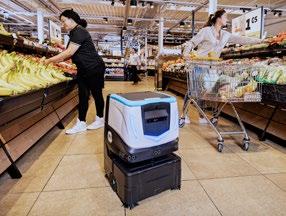

Retail cleaning solutions 20
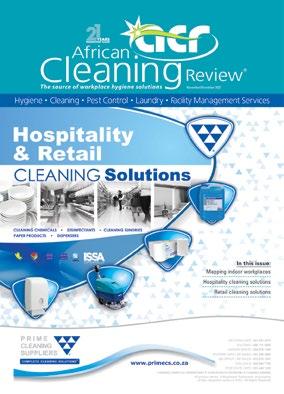
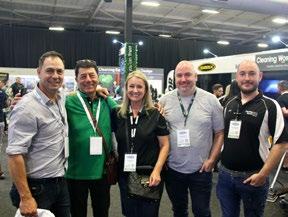
• Considering autonomous cleaning solutions for your retail facility? This is what you need to know
• Best practices for cleaning in a retail setting
Educational 25
• What is 4D cleaning and why is it increasing in popularity?
FM Review
• The future FM perspective
Laundry Review
• Hospitality industry laundry – win by optimising your processes
• Textile service industry digitalisation showcased
People and Events
• Goscor Cleaning Equipment celebrates opening of new premises in Johannesburg
New Products 32
• Innovative and professional orbital single-disc machine
• Eradicating single-use plastics
• KCP launches 100% bio-based and recyclable
•
Feature sections in every issue:
• Laundry and dry cleaning review
• Facilities management review
January/February issue: Editorial deadline 9 December 2022
• Contract cleaning
• Food and beverage hygiene solutions
Published by:
1 African Cleaning Review November/December 2022 20
26
28
30
core plug
Professional
with fleet management contents NOVEMBER/DECEMBER 2022 VOL 23 NO. 6
vacuum cleaning robot
Planned features for 2023
Official publication and media partner of:
15 13 30 REMINDER
List your company in the 2023 Buyer’s Guide. Complete the form overleaf to secure a presence in this sought-after annual industry reference guide.
opinion Mapping indoor workplaces from the editor
Focus on cleaning and hygiene calls for new solutions
We are entering this festive season that will be vastly different to the previous two years where COVID-19 pandemic regulations dictated our everyday lives. Therefore, this issue takes a closer look at cleaning in two industry sectors on the cusp of recovery following the disastrous effects of the pandemic.
The retail and hospitality sectors were possibly the hardest hit by the effects of the pandemic and now need to put their best foot forward in terms of presenting a clean, hygienic and welcoming facility where clients will feel comfortable about their well-being.
The pandemic ushered in a new era for housekeeping in hotels with certain multinational hotel chains having resorted to accreditation programmes to make their guests feel safe. Now, like never before, hospitality groups are prioritising cleaning and disinfection best practices within their facilities to protect guests and their employees.
A solution like autonomous cleaning that allow for consistent and efficient work can now become common in retail facilities. This, considering previous negative connotations associated with bringing on robots, is explored extensively to take cleaning to the next level.
With this, the final issue of the year, we at African Cleaning Review want to thank you for your continued support and wish you a safe and pleasant December holiday period. We look forward to sharing industry news, latest developments and details pertaining to the Cleantex Executive Summit, Cape Town 2023.
Enjoy the read.
The COVID-19 pandemic caught us off guard as it suddenly – and enduringly – upended indoor workplaces. For businesses that can support their employees who are working from home, Zoom and Microsoft Teams video calls have become the new normal. But bringing employees back into the indoor workplace has created significant challenges that employers need to prepare for, according to Dr Gavin Macgregor-Skinner, director of the Global Biorisk Advisory Council™ (GBAC), a division of ISSA.
The need for safe indoor workspaces
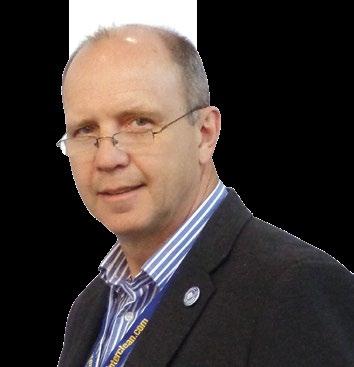
Indoor spaces pose a greater risk of spreading COVID-19 than the outdoors. Hospitals, airports, nursing homes, convention centres, stadiums, hotels, schools, manufacturing facilities, retail businesses, government buildings and other organisations that either could not let their employees work from home or brought their employees back early on, need effective ways to implement safety measures fast. Even organisations offering an ongoing hybrid model, where employees work from the office sometimes and at home the rest of the time, need to visualise hazards and risks in order to safely use their indoor workspace.
As organisations in cities, counties, states and countries around the world enter various stages of recovery, the GBAC, a division of ISSA, utilises the 20 Element GBAC STAR™ Facility Accreditation programme to help organisations analyse what it would take to bring their employees back to work. The priority is safety, and the focus is on creating a safe communal indoor working environment that employees feel comfortable returning to. This includes physical distancing requirements by reducing indoor capacity, evaluating air quality, and cleaning and disinfecting high-touch surfaces.
Diarrheal diseases, respiratory diseases and soft tissue infections have always illustrated the need for better health safety in the workplace.
But the SARS-CoV-2 virus that caused the COVID-19 pandemic has greatly accelerated having a workplace operations system in place that facilitates enhancing indoor-space safety. This includes the strategic placement of hand sanitisers and the ability to respond to overcrowding and cleaning and disinfecting surfaces that are touched often.
Mapping indoor workspaces
By mapping indoor workspace and using Element 7: Risk Assessment and Risk Mitigation Strategies of the GBAC STAR programme, facilities have made adjustments to how indoor spaces are managed across a range of sectors, increased employee awareness of the surroundings, and provided a much clearer common operating picture to those who manage facilities.
The GBAC STAR programme defines risk as a function of both the likelihood of something happening and consequences of that occurrence, i.e. ‘How bad can it get?’ GBAC STAR facilities use floor plans and indoor maps to identify hazards. They also use risk assessments to decide which are acceptable or unacceptable risks and what needs to be done to mitigate the risk.
GBAC STAR accredited facilities are using various tools for mapping indoor locations, such as paper-based floor plans, indoor GIS software and smartphone apps that provide actionable procedures to mitigate the risks of transmission of any infectious disease-
2
causing agents such as viruses and bacteria. Facilities use their indoor maps with Element 6: Program Controls and Monitoring to put in place documented procedures for monitoring the effectiveness of applied protocols and procedures. Many facilities are utilising technologies such as dashboards, quick response (QR) codes, Wi-Fi networks and radio-frequency identification (RFID) to monitor use of equipment, movement of people, and verify that cleaning and disinfection activities are completed.
GBAC STAR accredited facilities use technology to create a new level of knowledge and understanding when it comes to facility operations. Operations managers are mapping indoor spaces to better understand the hazards and the risks and to implement the most appropriate equipment, personnel and cleaning and disinfectant products for their work environment. They often must implement multiple complementary controls to prevent the spread of the SARS-CoV-2 virus.
Maps of indoor spaces, combined with photos and video, help determine where there are physical distancing conflicts, such as in staff breakrooms and washrooms, ensuring workspaces are compliant with health and safety regulations and maximum occupancy requirements. Mapping high-touch areas that require cleaning and disinfecting,
locations of hand sanitisers, people movement flow, hard floors and carpeted areas, etc., provides an easyto-understand risk assessment tool using the traffic light colours (red, yellow, green) that helps make working in the building safer.
Airports, convention centres, stadiums and hotels have implemented systems using QR codes and satisfaction feedback apps to report facility issues –for example, areas that need cleaning. This information is received immediately on a map to show the location in the building and viewed on a dashboard or mobile app by staff. Some systems allow the uploading of photos. When this information is submitted, cleaning staff receive a notification telling them precisely what and where the problem is. Then they can use the indoor map to navigate directly to the area of concern.
As part of Element 16: Facility Infection Disease Prevention Practices, mapping indoor spaces helps operation managers maximise the use and effectiveness of available resources such as equipment and cleaning and disinfection products, including task overflow to additional workgroups at peak demand of cleaning services. It also helps implement recommendations from both the U.S. Centers for Disease Control and Prevention (CDC) and the U.S. Department of Labour Occupational
Safety and Health Administration (OSHA) that employers’ COVID-19 response plans should utilise the hierarchy of controls, which generally labels and prioritises controls in the following order, from most to least effective: elimination, substitution, engineering controls, administrative controls and safe work practices, and personal protective equipment (PPE).
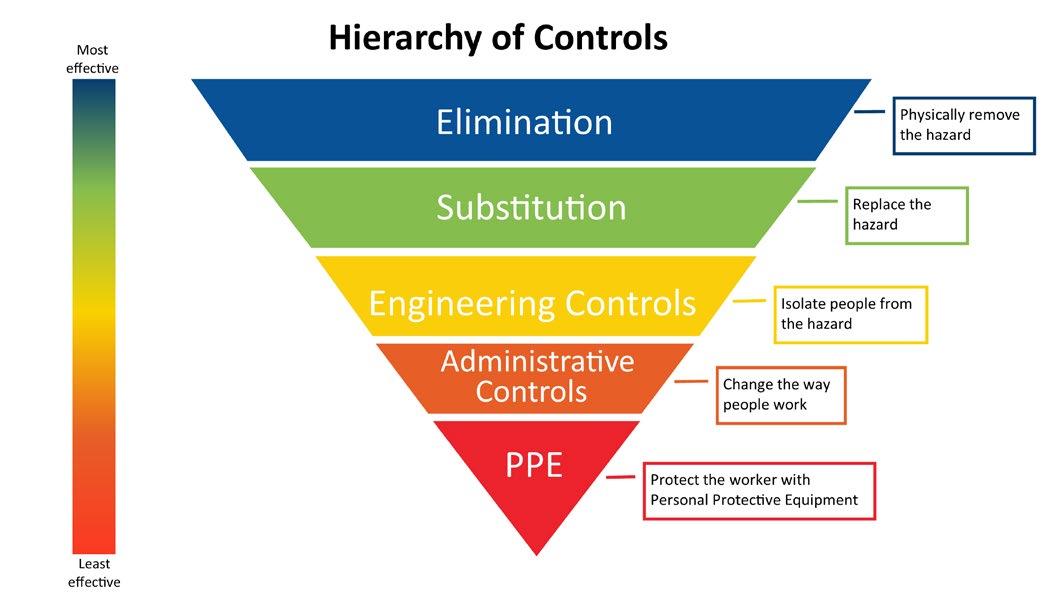
Engineering controls require a physical change to the workplace to isolate workers from a hazard. Examples of engineering controls that employers may find useful for protecting workers from SARS-CoV-2 include:
• Location of hand sanitiser and disinfectant wipe stations
• Installing plexiglass and other physical barriers
• Adjusting ventilation systems, consulting a qualified technician if necessary
• Location of no-touch technologies, such as hands-free entry/exit and waste disposal
• Administrative controls and safe work practices that change policies and procedures for how workers perform job duties to ensure work activities are conducted safely.
Examples of administrative controls that employers may find useful for protecting workers from SARS-CoV-2 include:
3 African Cleaning Review November/December 2022 opinion
Location of signs in languages that workers understand
Limiting the number of people in a room
































































































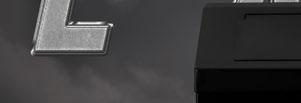





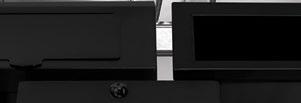








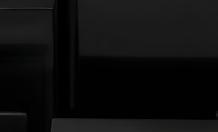
























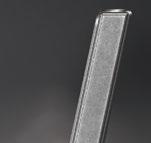

Providing training Increasing the frequency of cleaning and disinfection

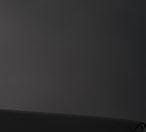
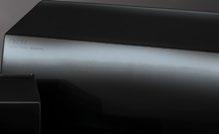

New tools, including indoor mapping, are being used to accommodate the rising demand for cleaning, infection control, risk assessment and gatekeeping of peoples’ movements, which is critical in managing the risks for COVID-19 and other infectious diseases.
In addition, GBAC STAR accredited facilities are using data analytics, which will draw insights on resource utilisation by using consumption data of cleaning products and the manufacturers dwell or wet contact time and how to increase capacity and reduce risk.
Using data focusing on resource utilisation helps management make key decisions across different indoor spaces and at various stages of the pandemic. Not only does this reduce costs, but it can also increase employee

confidence and happiness, help organisations differentiate themselves from the competition and better prepare businesses for other potential challenges.
Finding the quickest, most efficient, and – in times of a pandemic – the safest route is not always an easy job. Indoor mapping and mapping technology that enhances operations and improves efficiency of teams are being deployed to great effect. Cleaning teams that, in the past, travelled all through a building, are now being managed by location, allowing a system of ‘right person, right place, right time’. This has had a dramatic effect on efficiency and productivity and creates a safer working environment.
The COVID-19 pandemic has revealed that mapping indoor spaces can enhance facility safety. GBAC STAR facilities have used indoor maps to increase employees’ awareness of their surroundings and provide a much clearer common operating picture to those who manage facilities. Isn’t that something
we could all use when things seem so uncertain?
As an infection prevention expert and consultant, Dr Gavin Macgregor-Skinner works to develop protocols and education for the global cleaning industry to empower facilities, businesses and cleaning professionals to create safe environments.
References:
1. US CDC—Guidance for Businesses and Employers Responding to Coronavirus Disease 2019 (COVID-19) accessed on Feb 8, 2021, https://www.cdc.gov/coronavirus/2019-ncov/ community/guidance-business-response.html
2. US CDC—Cleaning and Disinfecting Your Facility accessed on Feb 8, 2021, https://www. cdc.gov/coronavirus/2019-ncov/community/ disinfecting-building-facility.html
3. OSHA COVID-19 Controls and Prevention accessed on Feb 8, 2021, https://www.osha. gov/coronavirus/control-prevention
4. OSHA Recommended Practices for Safety and Health Programs—Hazard Prevention and Control accessed on Feb 8, 2021, https://www. osha.gov/shpguidelines/hazard-prevention.html
4 African Cleaning Review November/December 2022 opinion
Dettol launches campaign to encourage handwashing

Dettol’s Mzansi Protect was launched during October – this immediately actionable initiative by Dettol aims to reduce the burden of diarrhoea in South Africa by 50 percent by 2027. While the message to wash hands during COVID-19 may have been internalised, there is a compelling case for continued education on good hand hygiene as a simple and effective action to prevent illness and diseases.
With the Stats SA General Household Survey 2020 showing that 42 percent of South Africans don’t wash their hands with soap and water, the need to drive handwashing education becomes even more imperative.
To realise this vision to reduce the burden of diarrhoea, Dettol also announced two incredible partnerships – one with The Nelson Mandela Foundation and the other with the





Springboks (SA Rugby) – who are the current world champions.
The relationship with the Nelson Mandela Foundation will help drive hygiene and handwashing education, as well as provide needed hygiene infrastructure to early childhood development centres across the country – ensuring no child is left behind.
According to Jurie Roux, CEO of SA Rugby, “It’s more important than ever to ensure fundamental hygiene measures are in place, and this partnership with Dettol will give us added reassurance that we remain vigilant in this area”.
Reckitt Marketing Director Umar Khan says, “We touch the head and the heart with our education and awareness campaigns, which for me is vital”.
The campaign media partner – the SABC – has also put its weight behind
Masibonge Mkhize, Reckitt head of corporate, external affairs and partnerships with Umar Khan, Reckitt marketing director.
the fight by communicating critical messages across its channels. Gugu Ntuli, the SABC’s Group Executive for Corporate Affairs, says, “As an institution that cares about the community it serves, the SABC is pleased to partner with a reputable brand like Dettol SA on such an important campaign – an initiative that addresses the challenges of our most vulnerable communities in our country”.
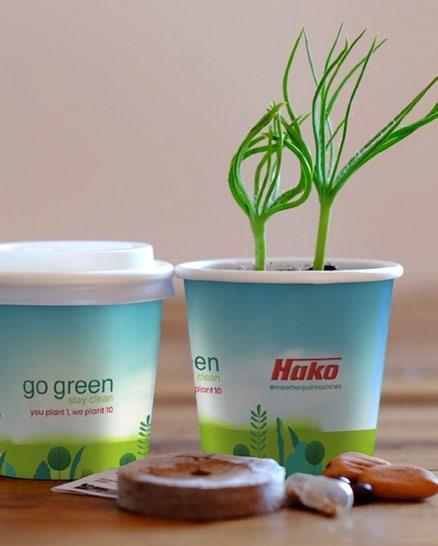
Hako Machines UK has joined ForestNation and its ‘You Plant, We Plant’ initiative as part of its environmental pledge to be a net zero company by 2023. Its involvement in the scheme, which see new trees planted in Tanzania that are cared for
and harvested by local villagers, was launched at the IMHX exhibition at Birmingham’s NEC with branded tree kits given to visitors so they could plant a tree of their own.
Managing Director Sylvie Giangolini said, “I discovered ForestNation while speaking at the Manufacturing Expo and was immediately taken with what they are trying to achieve. As important as our environmental pledge is, to also contribute to the growth and economy of these small villages in Tanzania was a great opportunity”.



For every tree kit given out, the company will plant ten trees in the Hako Machines Ltd Forest in a developing region of Tanzania to reforest Mother Earth and help create sustainable livelihoods for people that need it most.

Sylvie added, “We already have over 10,000 seedlings being nurtured to plant in our forest, which potentially reforests ten hectares of land, and we’re only just getting started! These will be planted towards the end of the year with the villagers actively protecting the forest from fires and trimming the trees in the event of
heavy rainfalls for the next five years.
“Our forest will be in the Eastern and Western Usambara Mountain Ranges, where heavy deforestation has ruined the livelihoods of many locals. By providing seedlings to families to plant on their farms, once matured, the trees will produce a regular harvest, yielding food and potential income.”
By cultivating 100 mature fruitbearing trees such as peach or avocado in the Hako Machines Ltd Forest, Tanzanian growers can earn an income of $173 and yield 10 tons of oxygen per year. Plus, it will offer employment to 200 women year-round and up to 800 women seasonally as well as empower students who visit the nurseries regularly to learn about horticulture and botany.
ForestNation is a for-profit sustainable business offering products and services that unite environmental, social and commercial goals while empowering individuals and organisations to reforest the planet and reconnect to nature. For more information on ForestNation and the Hako Machines Ltd Forest, visit https:// forestnation.com/net/forests/hako-machines-ltd/.
5 African Cleaning Review November/December 2022
industry news
Hako joins ForestNation as part of environmental initiative in Tanzania
RS Safety Solutions to provide focused PPE safety and hygiene product offering
RS Group plc, a global omnichannel provider of product and service solutions, announced on 1 November the launch of RS Safety Solutions as a new brand within the RS Group. RS Safety Solutions brings together the existing RS personal protection equipment (PPE) capabilities with the operations of Needlers and Liscombe, both of which are based in the UK.
RS Group acquired Needlers (Needlers Limited) and Liscombe (John Liscombe Limited) in 2020 and 2021, respectively. Both businesses are leaders in their fields with Needlers largely serving the food-processing industry with its PPE and hygiene products and Liscombe primarily operating in industrial sectors, where safety and personal protection is critical. This union offers a deep technical experience while combining over 300 years of expertise in this field.
The combination of the two businesses within RS Safety Solutions will enable the leveraging of their respective strengths to serve customers in industrial and foodprocessing markets and address their
requirements for PPE and safety and hygiene equipment. The unification also bolsters the huge potential for each of the forerunner operations and strengthens RS’s position as a major player in the PPE market.
“Following on from changing our name from Electrocomponents to RS Group, this is the latest step on the journey to rebranding all the RS operations,” says Pete Malpas, President EMEA at RS. “By uniting these two growth
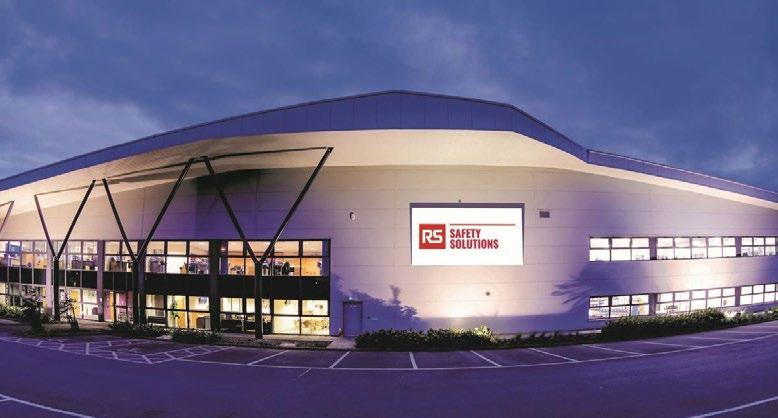
businesses under RS Safety Solutions, we can now deliver a fantastic offering in PPE, safety and hygiene products for new and existing customers in industrial and food-processing markets, all backed by the RS Group.”
RS Group plc is listed on the London Stock Exchange with stock ticker RS1 and in the year ended 31 March 2022 reported revenue of £2,554 million. For more information, visit https://za.rs-online.com/web/
The City of Cape Town’s anti-graffiti unit is making inroads in removing graffiti from general and cityowned buildings across the metropole.
The unit, which is part of the City of Cape Town’s Law Enforcement agency, has reportedly removed 18,356 square metres of illegal graffiti in the metro since the start of 2022.

According to the City of Cape Town, and in terms of the graffiti by-law, owners or occupiers of a property within the metro are responsible for the appearance of the properties and to ensure that it remains free of illegal graffiti on any wall, fence, building or structure.
City of Cape Town Safety and Security Mayco JP Smith said, “Unsanctioned graffiti, and particularly gang insignia or other anti-social sentiments that end up on walls, are an eyesore that brings down the tone of an area.
“Our graffiti unit has been hard at work for years, cleaning up after people who have scant regard for the property of others. But we want to emphasise that there is a space for this type of artistic expression, provided the artists or property owners go through the right channels.” Smith said that the graffiti unit works closely with various neighbourhood watches and other enforcement agencies to apprehend suspects.
Anyone caught in the act of writing or drawing graffiti on properties can be fined up to R1,500 for their first offence and be served with a compliance notice to have the graffiti removed at their expense.
6 African Cleaning Review November/December 2022 industry news
Anti-graffiti unit cleaned up 18,356 square metres of illegal graffiti
SUEZ completes EnviroServ acquisition
SUEZ, with Royal Bafokeng Holdings (RBH) and African Infrastructure Investment Managers (AIIM), has completed the acquisition of EnviroServ Holdings and its subsidiaries after approval by antitrust authorities. This acquisition will enable SUEZ to reinforce its positioning as an international leader in industrial and municipal waste treatment activities.
SUEZ has built more than 500 drinking water and sanitation plants that service most African capitals. SUEZ is present in Morocco, Egypt, Senegal, Tunisia and Ivory Coast. “This acquisition will enable SUEZ to reinforce its positioning as an international leader in industrial and municipal waste treatment activities and to strengthen its position on the African continent,” says Sabrina Soussan, chairperson and CEO of SUEZ.
“I am thrilled by EnviroServ joining SUEZ Group; this is a team with a unique track record over the past 40 years, which enabled the company
to become the leader in hazardous and non-hazardous waste-treatment activities in southern Africa. I am convinced SUEZ can further nurture the profitable growth of EnviroServ.
I am equally convinced that the team’s skills and talents will support SUEZ in expanding its activities in South Africa as well as in other geographies,” she says.
EnviroServ collects, treats and disposes of general and hazardous waste at treatment and disposal facilities across South Africa and Mozambique. Its customers include multinational firms operating in the petrochemical, manufacturing, metallurgical and mining sectors.
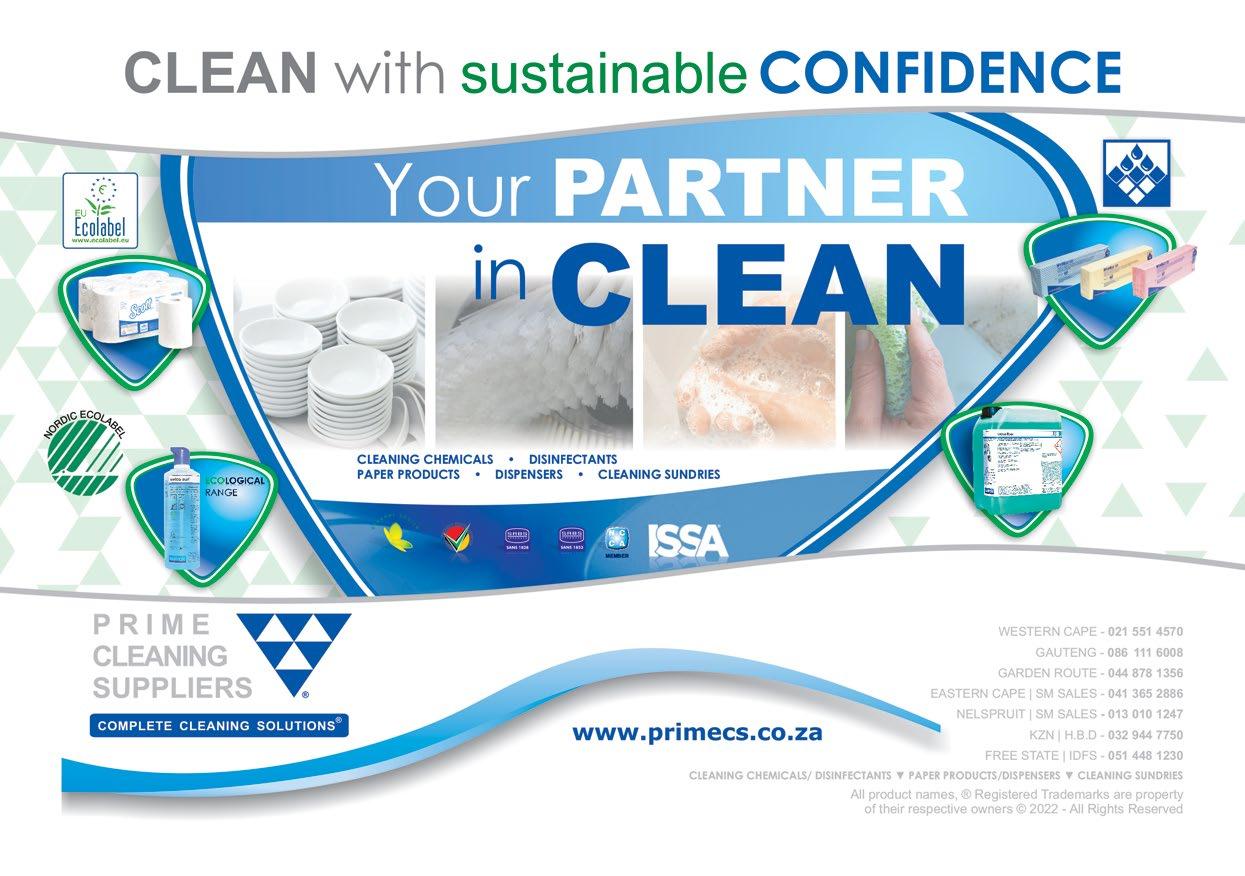
It recycles some 125,000 tons and manages 1.7 million tons of hazardous and general waste per year. Dean Thompson, CEO of EnviroServ, said that they looked forward to the knowledge and experience that their new shareholders would bring to the South African waste markets.
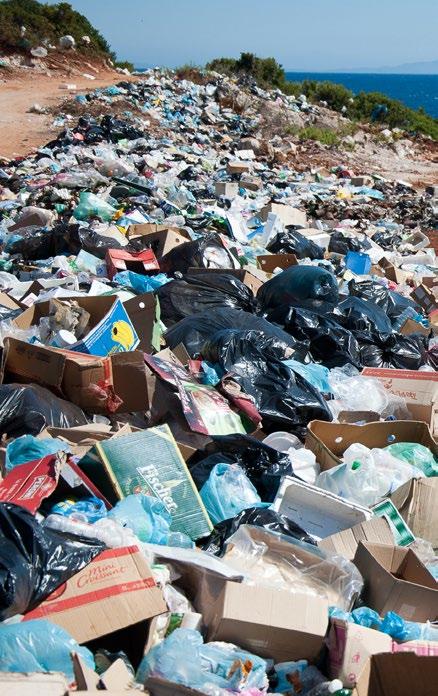
industry news
Advanced cleaning technologies helped save on MBSA cleaning expenditure



In need of a specialised cleaning team, Mercedes Benz South Africa (MBSA) were on the lookout for a supplier that could provide technological and innovative services for office and dealerships to workshop spaces. Soon, leading African integrated workplace management solutions provider Tsebo Cleaning became part of the integrated facilities management solution across MBSA’s headquarters, retail, commercial and passenger vehicle sectors.
To solve outdated practices, Tsebo Cleaning sought to implement their services that not only improved efficiency but would also assist in reducing costs. By introducing advanced cleaning technologies and methodologies to keep up the quality of MBSA across the board, Tsebo was able to save the company 20 percent on their cleaning expenditure. The Tsebo Cleaning team used their expertise to provide a higher level of quality service as well as tenable support.
“We need to remain the best and ensure that technology is top of mind. I am proud that our vision has not
only been achieved by us as a brand, but also by our suppliers. Our robotic vacuum is a great addition to our dealership and continues to impress all those who see it,” says Alex Boavida, Dealer Principle of MBSA, Sandton. Furthermore, Tsebo introduced its trademark colour-coded cleaning system. This helped the team determine what cleaning products and techniques best suit the job at hand and how to avoid crosscontamination – similar to what you would find in hospital cleaning services. The Tsebo team used eco-friendly cleaning products and efficient energy consumption to achieve the desired sustainable output. The advanced technologies and practices that Tsebo implements at MBSA vary from one operation to another. Such services include: the Operations and Quality Management App, Key-control App, i-Mop, and ‘Irene’ – Africa’s first cobotic vacuum.
With over 120 employees at MBSA and 131,000m2 of workspace to clean, Tsebo’s team manages to bring in a 20 percent saving over a four-year contract
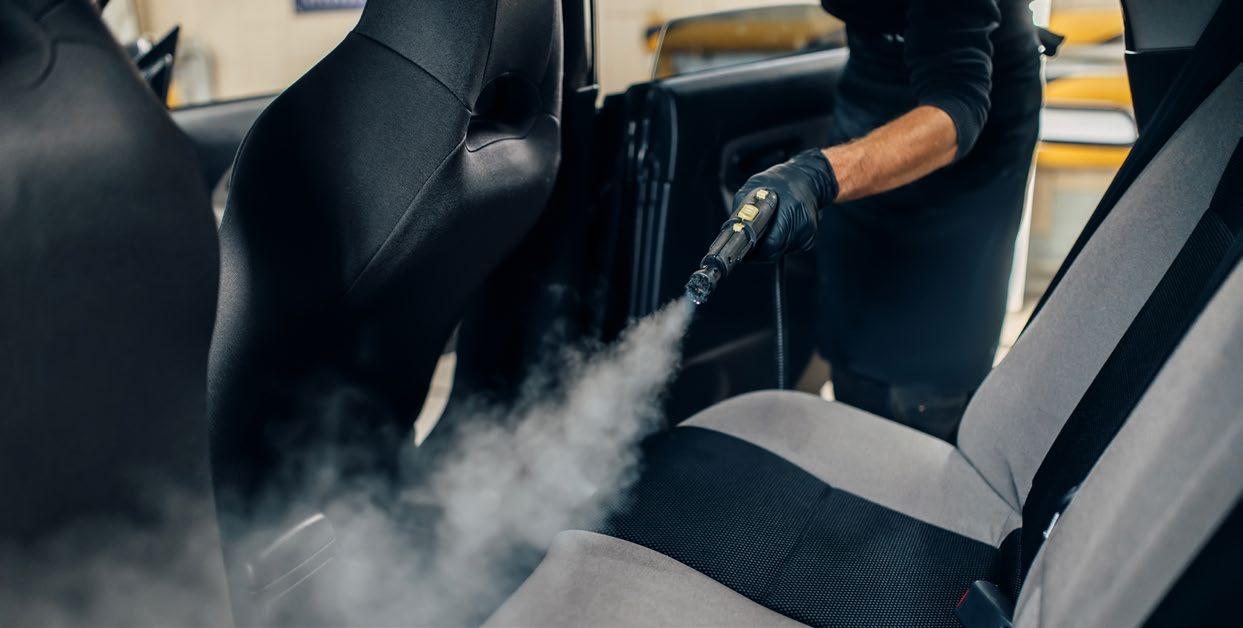
period. Moreover, the benefits have proved to go far beyond cleaning and savings. The Tsebo staff are well-trusted and incredibly reliable as they are highly trained and have round-the-clock access to senior management. Site-based contract managers and supervisors are also on standby to focus on quality control and address daily site challenges.
“Tsebo prides itself on the quality it provides to its clients and best-inclass innovation. As a proud partner to Mercedes Benz South Africa, the team went above and beyond to deliver, elevating a personal and professional touch that is setting high standards within each and every service,” says Monwabisi Kalawe, CEO of Tsebo Cleaning and Hygiene Services.
Tsebo Solutions Group offers clients reduced costs, risk and complexities together with increased quality, efficiency and productivity. The company specialises in catering, facilities management, cleaning and hygiene, pest control, protection, energy, procurement, workspace design, engineering, remote camps and more. For more information, visit: www.tsebo.com
8 African Cleaning Review November/December 2022 editorial Tsebo Cleaning
For more information regarding advertising / editorial / digital packages, email: nande@cleantex.co.za www.africancleaningreview.co.za Advertise in the primary African trade magazine for the commercial cleaning and hygiene sectors. Reach your target market cost-effectively with a direct link to end-users, building service contractors, facility management and key institutional segments.
Introducing the 244NX Compact Scrubber Dryer
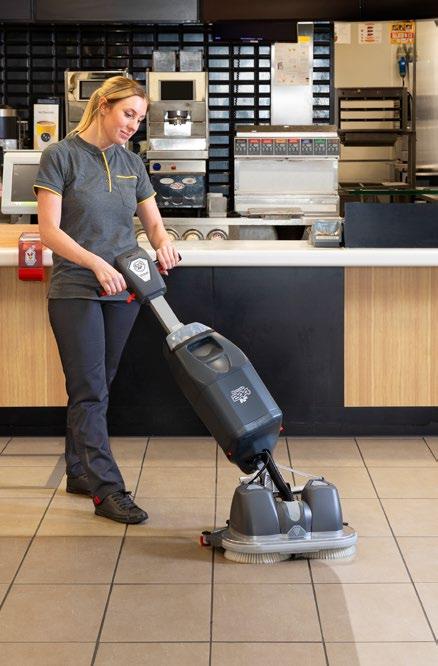
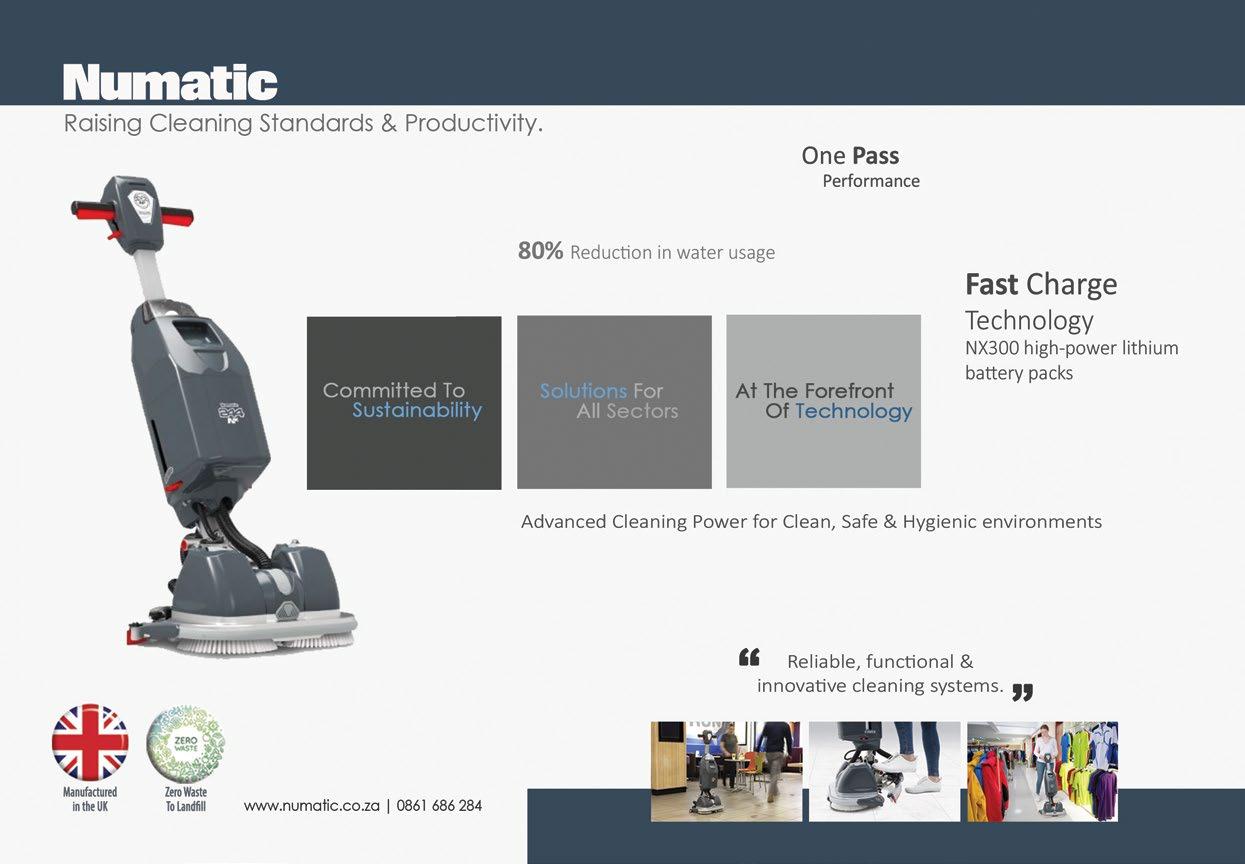
The new Numatic 244NX Compact Scrubber Dryer is your answer for a fast, effective and easy clean. Not only is it an innovative solution to cleaning and drying small or congested areas, it can reduce labour costs by 70 percent and water consumption by 80 percent! With the easy-to-use, highly manoeuvrable 244NX, you have a powerful, longlasting battery-powered floor scrubber that can be used just about anywhere.
Agile and lightweight, the 244NX easily ‘parks up’ while you move obstacles or carry on with other tasks. The lightweight design makes using it a breeze as well as being ergonomically better for you and your team. Plus, it’s easy on the environment, saving over 5,000 litres of water per year! It is also compatible with Numatic’s NuAssist App making training and maintenance simple, and it comes with either one or two NX300 batteries. These versatile batteries deliver Power Driving Productivity and features interchangeable with many other Numatic machines!
Features:
• 30 power-cell configuration delivers 300Wh of energy
• 440cm scrub width
• 2.2L solution tank
• 3L recovery tank
• 80-minute runtime per battery
• 1-hour fast charge for 80 percent, 2 hours for 100 percent usage
For more information, visit: www.numatic.co.za
editorial Numatic
feature hospitality cleaning solutions
The new approach to hotel cleaning
The novel coronavirus pandemic has ushered in a new era of housekeeping for hotels. Some large hospitality chains have turned to accreditation programmes to make guests feel safe, while others have developed cleanliness councils to ensure cleaning and disinfection best practices are being implemented. Hospitality groups and independent owners are prioritising cleaning and disinfection to protect guests and employees –and to instil customer confidence, according to Diversey’s Peter Teska.
As the purpose of cleaning transforms, C-suite executives, hotel managers and housekeeping teams must understand how to advance their environmental hygiene programmes. With a new approach built on a foundation of health and safety, organisations can prevent the spread of infection to protect employees, guests and building visitors.

The shift from cleaning for appearance
Prior to the pandemic, hotels primarily focused on ‘cleaning for appearance’ to secure five-star reviews and positive word of mouth. From shiny lobby floors to clean linens, properties focused on looking their best to make a good first impression. First impressions set the tone for a guest’s visit, so the visual presentation of a hotel’s interior and exterior must be carefully crafted and maintained.
However, when faced with a global pandemic ‘cleaning for appearance’ is no longer good enough. People have become much more concerned
with germs and expect that a hotel is ‘cleaning for health’ to control exposure to these threats.
‘Cleaning for health’ inactivates viruses and kills bacteria and fungi to limit the spread of potentially harmful pathogens. Cleaning with an emphasis on infection prevention prioritises giving guests a safe stay and also protecting workers. Given the scope and impact of the pandemic, increased expectations around cleanliness will become the norm as the tourism and hospitality industry continues to recover.
Taking cleaning to the next level
Best practices that hotels should consider when implementing a ‘cleaning for health’ programme include: • Consult with industry experts from the start – with the health of your employees and guests at stake, take the necessary precautions and build an environmental hygiene programme based on evidence and facts. Consult with infection prevention and hygiene experts to understand the how and why
behind cleaning and recommended protocols. Some hotels are working closely with medical centres and hygiene providers to establish best practices that everyone can follow.
• Implement safe products that are proven to perform – employees will need to clean more regularly and thoroughly, so they’ll be more exposed to cleaning solutions. A ‘cleaning for health’ programme should consider ways to protect housekeeping staff. For example, review the ingredients and manufacturer’s instructions for each product to ensure they don’t pose any risks.
Choose hospital-grade disinfectants that clean and disinfect at the same time and don’t require two applications. Make sure that disinfectants are tough on pathogens, but gentle on people and surfaces to prevent eye and skin irritation and surface damage. Additionally, confirm that the contact time is reasonable, as
10 African Cleaning Review November/December 2022
it will be difficult for employees to keep surfaces wet for extended periods of time.
• Conduct quality training – a more rigorous and evidence-based approach to cleaning can only be successful if employees understand the expectations, processes and mistakes to avoid. Focus on how to properly disinfect, which requires thorough application over the duration of the contact time, followed by wiping to eliminate residue. Highlight ways to avoid cross-contamination, protocols for dealing with confirmed coronavirus cases (or other serious illnesses) and the importance of proper
chemical dilution if chemical concentrates are used.
• Make your commitment to cleanliness and your processes more visible – make your dedication to hygiene known. Post signage throughout the property, such as in lifts, guest rooms and fitness centres, that highlights how you are cleaning and disinfecting. Develop a cleaning schedule for housekeeping, front desk and bar and restaurant managers to follow. Cleaning while guests are present helps to prevent the spread of germs and demonstrates a hotel’s pledge to maintain high cleanliness standards.

A safe and healthy ‘home away from home’
As hotels continue to reopen, there will still be uneasiness about travelling and staying away from home where there is less control over cleanliness. To overcome this, hotels will need to clearly communicate the steps they are taking to protect guests. As cases of coronavirus drop and a vaccine emerges, the industry will rebound as people become more comfortable with travelling. Hotels that have demonstrated a commitment to health and safety will have a greater chance of winning and maintaining loyal customers in the long term.
feature hospitality cleaning solutions
‘Cleaning for health’ inactivates viruses and kills bacteria and fungi to limit the spread of potentially harmful pathogens. Cleaning with an emphasis on infection prevention prioritises giving guests a safe stay and also protecting workers. Given the scope and impact of the pandemic, increased expectations around cleanliness will become the norm as the tourism and hospitality industry continues to recover.
Seven ways to optimise sanitation in restaurants –front and back of house

Today, customer expectations for restaurant hygiene are increasingly high. According to the second instalment of The New Normal for Restaurants study1, sanitisation standards are now top purchase criteria in the foodservice industry – having not ranked highly prior to the pandemic. In fact, customers tend to spend twice as much in restaurants that demonstrate high cleaning standards2
When customers visit a restaurant, visible cleaning is now an unspoken requirement. Building customer confidence means demonstrating frequent surface cleaning of hightraffic zones, pristine table hygiene and ensuring employees are seen engaging in handwashing and sanitisation. Cleanliness will always be a crucial factor in attracting new customers –and it’s vital for ensuring existing guests return to eat at your restaurant time and time again. With that in mind, we bring you seven simple but effective ways to optimise sanitation – for both front and back of house.
1. Ensure your cleaning products are fit for purpose
When it comes to cleaning, sanitising and disinfecting your restaurant, investing in high-quality cleaning products will ensure each job gets done thoroughly. Remember, there is a difference between cleaning, sanitising and disinfecting3, which means they require bespoke products:
• Cleaning: Removing dirt from surfaces (with soap and water)
• Sanitising: Reducing pathogens on surfaces (with an anti-bacterial solution)
• Disinfecting: Removing all microorganisms from surfaces (with an anti-viral solution)
2.
Create a surface-cleaning schedule
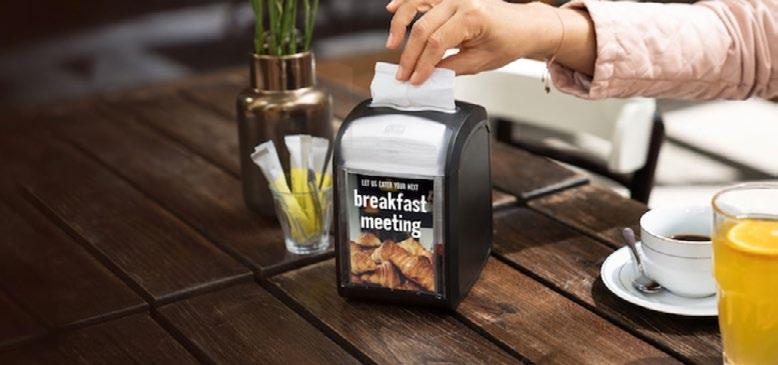
To ensure a safe and hygienic eating environment, it’s important that restaurants keep up with surface cleaning high-touch surfaces. Frontof-house waiting staff should pay
attention to menus, tables, chairs, countertops, door handles, light switches, dispensers and credit card machines. Back-of-house kitchen staff should pay attention to door handles, light switches, dispensers, food-contact surfaces, hand-contact surfaces, sink faucets, handles and utensils. With so many different zones to clean throughout the shift, it can be helpful to create a clear surface cleaning guide for both front-of-house and back-of-house employees to ensure that no surface gets neglected.
12 African Cleaning Review November/December 2022 feature hospitality cleaning solutions
Tork Xpressnap Fit napkin dispenser
3. Switch to a more effective napkin solution
Napkins are a key product that help customers keep themselves and their table free of mess and spills. However, refilling napkin dispensers and fulfilling guest requests for more napkins can be time-consuming for busy front-of-house staff. To help improve hygiene and efficiency at the same time, consider investing in new innovations that make cleaning up easier for customers. Tork Xpressnap Fit is a fully covered napkin dispenser that promotes better hygiene by protecting napkins from dirt and moisture. One-at-a-time dispensing means guests only use the number of napkins they need, which saves time spent on both cleaning and refilling.
4. Prioritise a hygienic washroom experience
Many customers will judge a restaurant by the quality and hygiene of the washroom facilities. A bad impression here can have a serious impact, so regular sanitising of washrooms is paramount to the entire experience. As a rule, busy restaurants should disinfect toilets, mop washroom floors, clean handwash basins and refill soap dispensers between 6 and 10 times every day, with regular deep cleans scheduled too. Consider installing high-quality air fresheners in your washrooms to ensure that customers are greeted with a pleasant aroma.
5. Engage in visible front-of-house cleaning
Once upon a time, it would have been very unusual for guests to see restaurant employees engaging in key cleaning duties, which would typically be done before and after shifts or during quiet periods. These days, important cleaning tasks that would usually take place behind the scenes are being brought to the forefront to enhance customer trust. Now 85 percent of guests actually want to see visible proof of strengthened sanitisation procedures4 – it makes them feel reassured that hygiene is paramount. Employees should confidently engage in visible hand sanitisation, wipe down surfaces such as tables and sweep up debris from the floor to enhance the guest experience.
Cleanliness will always be a crucial factor in attracting new customers – and it’s vital for ensuring existing guests return to eat at your restaurant time and time again. With that in mind, we bring you seven simple but effective ways to optimise sanitation – for both front and back of house.
6. Increase kitchen sterilisation measures
Kitchen staff are often incredibly busy, particularly at peak mealtimes, so implementing a few measures to help improve hygiene in the back of the

7.
Improve hand hygiene by optimising dispenser placement
restaurant can go a long way. Start by ensuring that appropriate cleaning products and cloths are placed on every workstation so staff can clean up spills as they go – preferably reachable with one hand. When the restaurant is calm and quiet, back-of-house staff should spend time cleaning and organising the kitchen as required to prepare for further busy periods. To aid sanitisation in the back of house in your restaurant, try to declutter and remove any unnecessary objects that prevent thorough cleaning.
To improve overall hygiene in the restaurant, consider optimising dispenser placement to prevent crosscontamination and reduce the spread of germs. Hand sanitiser dispensers should be set up for easy accessibility for both guests and employees. Touchfree hand-sanitiser dispensers are a great idea because you have even more options for convenient placement, such as fixed to a wall for ease of use.
Sources:
1 Simon Kucher: Restaurant Sanitization Standards
2 QSR Magazine: Restaurant visitation criteria
3 Medline Plus: Cleaning, sanitizing, disinfecting
4 Restaurant Business: Customer perception of value
13 African Cleaning Review November/December 2022
feature hospitality cleaning solutions
Dust minimised with Hako innovation
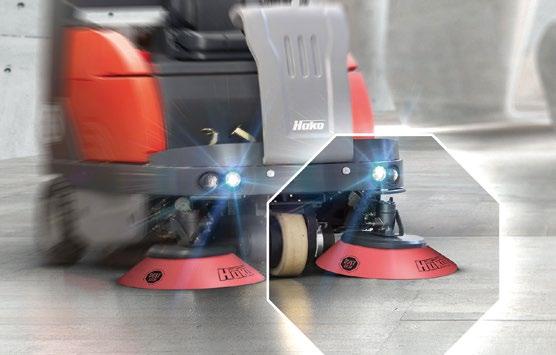
When sweeping heavily soiled and dusty floors, it is almost impossible to avoid dust generation. With Dust Stop, cleaning equipment manufacturer Hako has developed an innovative solution that reduces emissions of fine dust during sweeping by up to 90 percent – a huge leap forward in work safety and protecting the health of cleaning machine operators.
Even though the rotating disc brushes of sweepers effectively collect dirt and light debris, they raise ambient dust as well. To counteract this, Hako has developed the industry-first Dust Stop disc brush jacket, which is available for all ride-on Hako sweeping machines and scrubber-driers fitted with a sweeping attachment.
Consisting of an elastic cover made of high-quality and eco-friendly Linatex rubber, the Dust Stop jacket lies directly on the bristles of the side broom. This stops the air-generating effect of the rotary motion, preventing the spread of dust that is stirred up during the sweeping process. Dust Stop increases both work safety and productivity and is also of particular importance in warehouses, where cleanliness is a decisive factor for proper storage.


The Hako Dust Stop can be retrofitted easily – no dust suction or technical installation is required. Dust Stop is the latest in a number
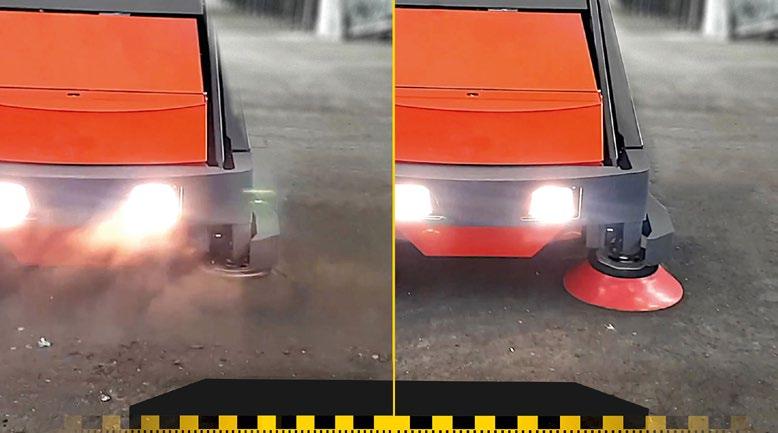
A CLEANER SWEEP


of innovations by Hako to make its sweepers and scrubber-driers more economical and efficient to operate while offering environmental protection. Two other examples are Hako-AquaControl, which saves up to 50 percent of water through intelligent brush systems and an automatic waterstop system when the machine comes
to a halt, and an on-board dosing system, which adds just the right amount of cleaning detergents in order to minimise the costs of chemicals.
For more information on the Hako range or a demonstration, contact Wouter Niemann at BHBW on 065 650 3839 or email: wniemann@bhbw.co.za
Other benefits of the Hako Dust Stop include:
• It allows unrestricted sweeping close to walls or racks, without damage to objects.
• The jacket reduces noise pollution.

• It eliminates the need to use water or compressed air.
• No additional energy consumption, since the jacket rotates with the side broom.
• In comparison to working with naked bristles, Dust Stop minimises the danger of debris being catapulted out of the sweeping path.
For more information, please contact Wouter Niemann on 065 650 3839 or email WNiemann@bhbw.co.za
14 African Cleaning Review November/December 2022
editorial BHBW Hako
Dust Stop delivers up to 90% less dust than conventional side brooms
A Hako sweeper operating without (left) and with (right) a Dust Stop disc brush jacket.
Bringing African cleaning professionals together
Following a period of three and a half years since the previous show, the African marketplace for professional cleaning and hygiene, Cleantex Africa, returned during October. This year’s exhibition, which hosted a record number of 131 brands, offered a long overdue opportunity for visitors and exhibitors to reconnect again in person with like-minded individuals and suppliers from across the cleaning and hygiene value chain.
Considering that the final COVID-19 regulations were repealed only four months prior to the show, this was indeed an exceptional event that delivered 3,490 visitors, an increase of 14 percent compared to the 2019 event. Visitors and delegates included representation from eight African countries and exhibitors from Romania and the UK, bolstering numerous opportunities for networking, education and new product discovery business development and collaboration between exhibiting companies.
The co-located Summit Cleantex Africa offered delegates a day filled with professional development sessions that included presentations on leadership, teamwork strategy, sales presentation and the customer experience, as well as insights into organisational culture to motivate and inspire success.





“We are delighted to see the return of normality in society; the ability to congregate as an industry was long overdue. We have noticed a good mix of senior level visitors coming through the doors to discuss post-pandemic industry trends and explore business opportunities. The incredible buzz in the hall is testament to the fruitful and engaging conversations taking place between exhibitors and visitors”, said Exhibition Director Johann van Vuuren.
The next Cleantex Africa exhibition will take place from 16–18 October 2024 in Johannesburg.

15 African Cleaning Review November/December 2022
review Cleantex Africa 2022









16 African Cleaning Review November/December 2022 review Cleantex Africa 2022












17 African Cleaning Review November/December 2022 review Cleantex Africa 2022
Buying in bulk is often seen as the cost-effective and sustainable choice. But when it comes to hand hygiene, are you really getting what you expect – and pay for? With 80 percent of germs spread by hands1 and viruses able to survive on hands for up to five minutes after transfer from a surface2, preventing the spread of germs in your facility is a must. But against the backdrop of rising costs and increasing pressure to be greener, how can you be sure you’re getting best bang for your buck?
In this article, the hand hygiene experts at Rubbermaid Commercial Products (RCP) bust the myths of buying soap and sanitiser in bulk.
Myth: Topping up stops it totting up If you want to save money, you buy in bulk, right? Not when it comes to soap and sanitiser dispensers. These dispensers distribute unnecessarily large doses of soap or sanitiser and the less concentrated product results in more wastage and more frequent refilling, adding unnecessary cost and hassle you don’t need.
The solution: Choose dispensers that use sealed refills for controlled dispensing and more applications per refill. A necessary amount of product for a safe clean – say 0.4 ml – is dispensed without the unwelcome wastage.
Myth: If there’s soap or sanitiser, you’re doing the job Unfortunately, not all hand hygiene is created equal. In fact, at least one in four bulk-fill dispensers is contaminated with illness-causing bacteria3. This is because
Busting the myths of buying in bulk for more cost-effective, hygienic and sustainable hand hygiene
there are multiple points on the dispenser where bacteria can contaminate the replenishment supply, such as an opentop lid and push-button. Often, units don’t get cleaned but are ‘topped up’ against guidelines4 and then cannot be decontaminated; an infected unit must be fully replaced to remove the risk.
With workers averaging three sick days per year5 productivity losses through germ-spreading in your facility are high: if your business has just 100 employees, it could be the equivalent of €35,100 a year6. Making sure your hand hygiene provision isn’t contributing to the problem is therefore a must.
The solution: Go for dispensers that use hygienically sealed refills to keep soap and sanitisers fresh and free from cross-contamination.
Myth: As long as it’s there, no one cares
People’s perceptions of your brand are formed by the experience you give them at every touchpoint. Your washroom is no exception – in fact, 74 percent of people say dirty washrooms cause negative perceptions7. With 66 percent of people saying they use a variety of methods (including flushing the toilet with their feet!) to avoid making contact with anything in a washroom8, offering a touchfree washroom experience will build your reputation as a brand that takes its users’ experience seriously.
The solution: Provide touch-free soap and sanitiser dispensers, which are preferred by 92 percent of people,9 and show you take their experience and wellbeing seriously.
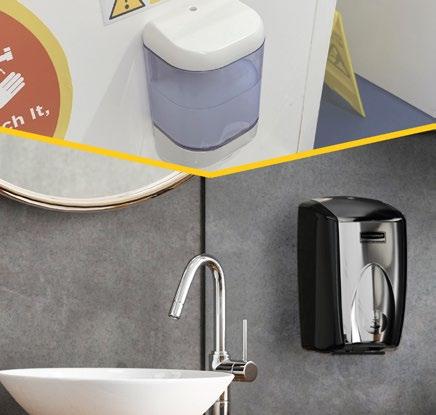
Myth: Buying in bulk is the greener choice
Bulk-fill dispensers may be cheaper at the outset, but their notoriously flimsy construction means you run the risk of having to replace them regularly. Not only is this costly for your budget but it also generates unnecessary additional waste.
The solution: At RCP, we encourage our customers to ‘Buy Better, Waste Less’, which means prioritising durability so your products last longer, improving sustainability. Look out for long product warranties on dispensers to get that peace of mind.
And if you want to go even further, innovative battery-free dispensers take greener hand hygiene to a new level. The RCP LumeCel™ AutoFoam dispenser, for example, is powered by natural or ambient light sources in your facility, negating the need for batteries.
For more information about RCP’s touch-free, cost-effective hand hygiene solutions, visit: www.rubbermaidsa.co.za Sources
salary taken from Olive Pometsey, GQ Magazine
RCP Facebook Hand Hygiene Survey 2020
18 African Cleaning Review November/December 2022 editorial Rubbermaid Commercial Products
1
2
3
4
5
6
7
8
9
University of Arizona Study, Dr. C. Gerba
The Journal of Infectious Diseases
Journal of Environmental Health 2011
CDC.gov Guideline for Hand Hygiene in Health-Care Settings
BLS.gov.
Average
Cintas
Impulse Research Corporation Survey
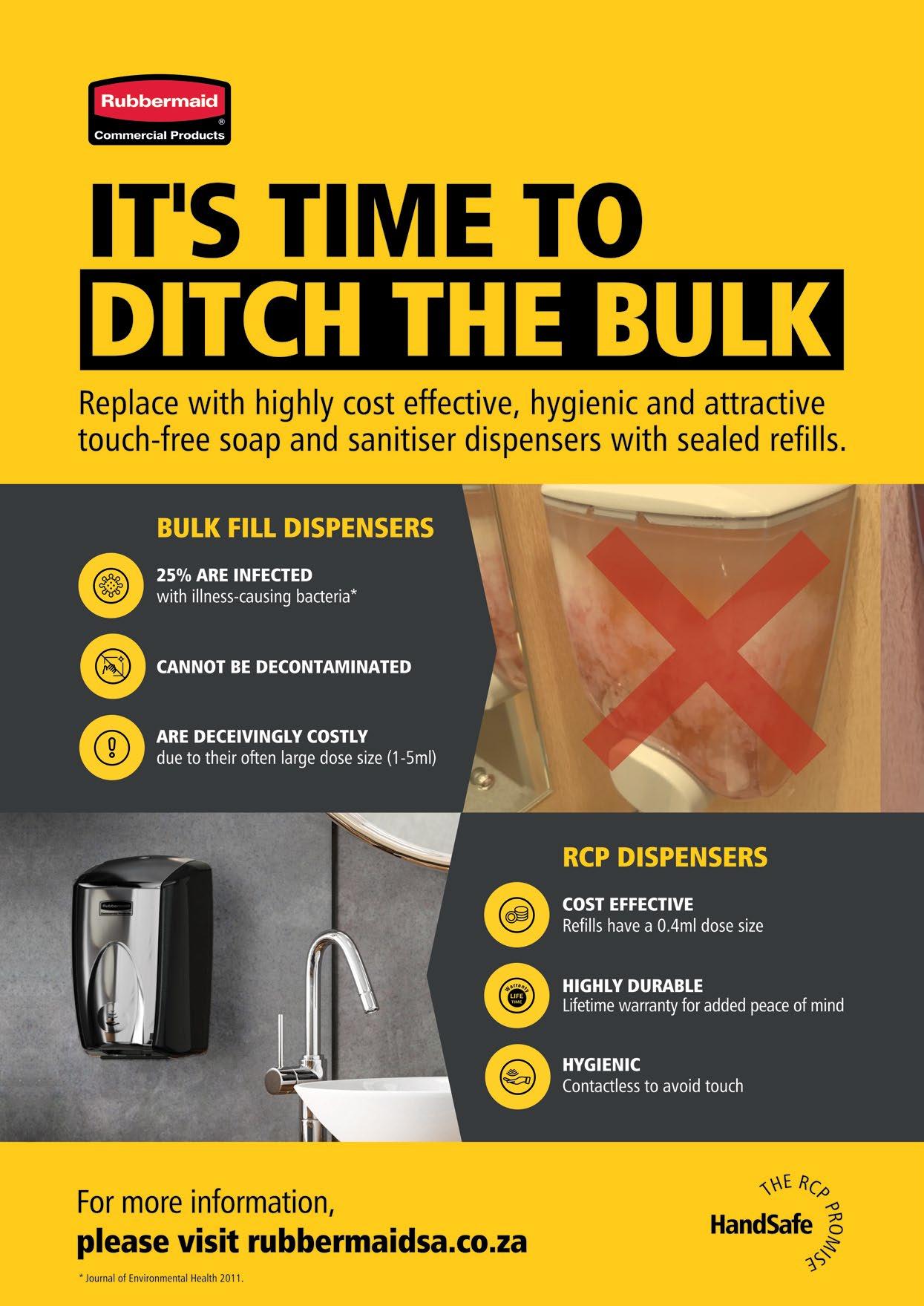
Considering autonomous cleaning solutions for your retail facility? This is what you need to

know
As technology continues to evolve and businesses work to offset labour and inventory issues, relying on the consistent and efficient work of robotics is becoming a necessary solution. However, before diving in headfirst, there are some steps employers and businesses should take when setting out to determine if they are a good robotics candidate, according to ICE Cobotics, a technology and cleaning solutions company working to improve well-being worldwide.
1. Ensure your team is ready to embrace autonomous solutions Perhaps one of the most important items on the list is preparing your staff.
There can be negative connotations associated with the idea of bringing on robots, so getting ahead of these stigmas is important.
Providing your team with an introduction to robotics ahead of bringing on the equipment can help put minds at ease.
Brian Hughes, in an editorial for Automation News, points out that employees often see the idea of AI adoption as leading to the elimination of jobs. However, when you explain to employees that autonomous solutions like cobots (collaborative robots) are there to support staff, it can make more sense.
Hughes suggests emphasising the ideas behind adding automation such as the ability to free up staff to focus on customers, learn new skills, and focus on other high-priority tasks.
“I see positioning AI tools as a strategy for improving productivity
and opening up job opportunities for employees as a necessary factor for successful implementation.”
Another way to look at it is with the term cobot, or collaborative robot. These autonomous solutions are designed to work alongside staff to help them tackle daily tasks. So, they are not only a solution for labour shortages, but they are a solution to aid staff too, as cobots take on repetitive tasks so staff can focus on more detailed and highpriority tasks.
2. Provide training about robots and autonomous solutions
Providing training is another good way to help staff adjust. Most equipment providers have training programmes that are easy to use and easily accessible.
For example, a cleaning technology and solutions company has a virtual resource centre that provides tutorials for each of their machines, as well as brochures and manuals that can easily be accessed by anyone.
Training staff not only helps them to feel more comfortable working with cobots, but it also gives them the chance to learn a new skill.
In addition, overseeing and deploying a cobot is a great way to give an employee a sense of ownership and more responsibility – something many employees want from a job.
3. Plan to prepare your physical environment for automation
Of course, when it comes to deploying floor-cleaning cobots, you will want to make sure you find the right machine for your floor type. Carpeted floors typically require an autonomous vacuum sweeper, and hard surface floors require an autonomous scrubber to get the desired results.
Bringing on autonomous solutions is not as simple as procuring the robot and deploying it in an office or retail environment. Just as it is important to prepare employees ahead of time, it is important to assess the physical environment too.
20 African Cleaning Review November/December 2022 feature retail
cleaning solutions
The technology used in autonomous solutions is continuously developing and most of the autonomous-cleaning, inventoryscanning and warehouse-product-movement robots have very sophisticated navigation systems. These machines can navigate realworld environments and avoid obstacles. ICE Cobotics’s autonomous scrubber, for example, uses VSLAM technology similar to what Tesla uses in their self-driving cars. The AI is highly sophisticated and uses a combination of cameras and sensors. Cobi 18 can even navigate safely around mirrors, through bright light and in the dark.
The issue has less to do with the navigation and more to do with the layout of your facility in terms of making effective use of the machines. For optimal usage and benefit to staff, it is important to make sure ‘unintended’ obstacles are picked up before deployment of the robot.
For example, in retail locations this can mean a quick scan of aisles to remove fallen goods. In office settings, this can mean making sure chairs are pushed in and trash and waste receptacles are lifted off the floor or are in their typical spot. Too many items left in the robot’s path can cause it to have to stop and adjust, slowing down its progress and interfering with efficiency.
It is important to remember that autonomous solutions need staff to support them, just as staff need the cobot’s support. Training staff to prepare the route for the cobot will go a long way towards making the implementation of autonomous solutions easier in your facility.
4. Determine where autonomous solutions can have the most impact on your business
This is a ‘get the most bang for your buck’ scenario. Evaluating the work that is done in your facility and determining what tasks should be handled by your staff is crucial to the successful deployment of cobots. For example, the ability to upgrade your customer service could expand when using cobots. Deploying a cobot to clean the floors relieves staff from worrying about checking that task off the list.
Instead, they can spend their time building relationships with customers and making sure customer needs are met. This can have a remarkable effect on business as good experiences drive customers to become loyal patrons.
Floor cleaning can be automated due to the repetitive nature of the work. Deploying cobots, like Cobi 18, an autonomous scrubber, can free up staff to focus on customers and other daily tasks while the floors are being cleaned by the cobot.
5. Be an early adopter
of innovation
Embracing autonomous solutions and innovation throughout the company is crucial to make implementation successful, for a few reasons. It:
• Shows that not only one department is embracing cobots
• Emphasises innovation as a company-wide initiative
• Shows automation is important to overall business success
• Makes it easier to adopt autonomous solutions throughout the business
Improve washroom hygiene and efficiency with Tork SmartOne – by far Europe’s #1 Centrefeed toilet paper system
Washroom hygiene is now more important than ever. Facility managers have an opportunity to meet people’s heightened expectations with a proven toilet paper solution – Tork SmartOne®
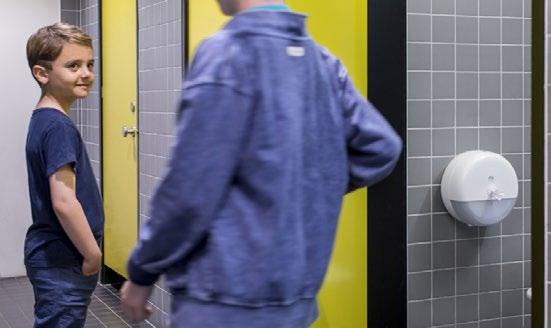
Introduced over 15 years ago, SmartOne is the first-of-its-kind toilet paper system and continues to be the go-to solution for facility managers.
Tork SmartOne is the original, #1 centrefeed toilet paper system in Europe, trusted by more facility managers than any other solution today. When you need an efficient, durable and sustainable toilet paper system, you can depend on Tork SmartOne.
High capacity Tork SmartOne means increased availability to support hygiene compliance, fewer washroom or locker-room delays, and less waste (thanks to one-at-a-time dispensing). No matter your site’s size, there’s a Tork SmartOne solution for you.
Tork SmartOne delivers:
Hygiene
Innovative design reduces risk of cross contamination by dispensing one sheet at a time, allowing people to touch only what they use. Further, Tork SmartOne Mini Twin’s independent doors ensure the dispenser’s second toilet paper roll is completely protected when the other compartment is being refilled.
Capacity
Serves more than 360 of your guests between refills and features 50% more capacity than a single mini jumbo tissue system.
Efficiency
Thanks to its high capacity, Tork SmartOne runs out less often and requires less refill checks, freeing up valuable time to address more pressing hygiene needs.
Sustainability
Hygienically dispenses one sheet at a time, reducing product consumption by up to 40% compared to traditional jumbo roll dispensers and helping you meet sustainability goals.
Durability
Dispensers lock to prevent pilferage – eliminating unnecessary costs for you to replace product – and resist vandalism in demanding environments.
Quality Refills
Provide performance, quality and softness at a balanced cost. This includes soft tissue with high brightness which leaves a lasting positive impression on your visitors.
For more information on Tork SmartOne, click here.
21 African Cleaning Review November/December 2022
continues on page 22 >>
“I see positioning AI tools as a strategy for improving productivity and opening up job opportunities for employees as a necessary factor for successful implementation.”
• Makes adding updated autonomous solutions easier with time
• Can position your business as a leader
• Helps keep your business and employees relevant
• Keeps your company moving forward and embracing change
As TechRepublic notes, “Businesses need to begin adopting AI technologies to help them do work, or risk being left behind”.
6. Keep the budget in mind and be open to new financing options Until fairly recently, investing in autonomous solutions was costly and prohibited many businesses from making the change. However, the technology that is used to navigate autonomous solutions like Lidar and ultrasonic sensors and 3D cameras has become more affordable, mainly due to:
• Falling sensor prices
• Open-source development
• Rapid prototyping
• Convergence of disparate technologies
“The demand for mobile computing has been a boon for robotics development, leading to falling prices,
rapid advances, and efficiency of sensor technology,” according to TechRepublic. Still, it is important to evaluate your budget ahead of time to help determine where cobots will be the most beneficial, where they may offset labour costs, and to plan for service and repairs along the way. In addition, exploring financing can open up unexpected possibilities.
A. With the ICE Cobotics all-inclusive subscription, service and support are offered throughout the duration of the contract. This alone can have many cost-saving benefits because if a cobot needs servicing, it is covered with the subscription. Part of budgeting means planning for service and repairs. If an equipment provider does not cover this, your business will need to plan to cover these costs. While we can hope machines will not malfunction, at the end of the day, this is a reality for all equipment.
B. Paying for an autonomous machine outright can deplete cash on hand and have an impact on company cash flow. Plus, monthly payment options are predictable and help to keep cash on hand for other business expenses or future job bidding.

C. Lastly, ICE Cobotics’s all-inclusive subscription includes their fleet management technology i-SYNERGY plus any updates that come through. Many equipment providers charge extra for this service and technology, and it can be costly.
7. Be prepared to change cleaning operations
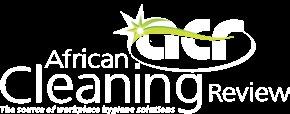
One of the benefits of using robots is the data-tracking technology. Robots are a part of the IoT or Internet of Things – a complex system of cloud-based technology that works through cellular and wireless networks and stores data.
ICE Cobotics has its own patented fleet management system, i-SYNERGY – a fleet management software that captures the data collected by the cobot.
This system tracks where the cobot cleans, how often it runs, the duration of time it runs, and even who uses the machines. This data can help managers and end-users to streamline processes and to work with employees to create better protocols or plans for tackling tasks each day. This can have a significant impact on how your business manages workflow.
Being prepared to evaluate the data and implement change is necessary to the overall successful implementation and to positively impact the bottom line. Preparing staff ahead of time for this and working with them along the way can help make business procedures run more smoothly and efficiently and can make the transition to using cobots simpler.
In general, bringing on cobots, or autonomous machines, can improve working conditions and offset labour issues, plus improve productivity and efficiency. Making sure the business is ready and set up for these changes is a key step to improving business operations.
For more information, visit: https://emea.icecobotics.com
22 African Cleaning Review November/December 2022
retail
feature
cleaning solutions
Contact us for more information regarding cost-effective advertising options: africancleaningreview@cleantex.co.za | www.africancleaningreview.co.za Promote your company in The Source of Workplace Hygiene Solutions! Reach your target market cost effectively by advertising in African Cleaning Review. The direct link to end-users, building service contractors, FM service providers and key institutional sectors.
Best practices for cleaning in a retail setting
Investing in a robust floor-care programme for your retail setting will help build your brand, keep your customers and employees safe and maintain a clean indoor environment.

First, consider your line of defence. In the entranceways, preventative matting can help to keep dirt out of your store. Second, you’ll want to invest in innovative equipment and technologies that make cleaning simpler, along with strategies that make the most effective use of your employees’ time, rather than aiming for shortcuts. Such strategies and equipment may prove to be more cost-effective in the long run.
A note about spills in the retail setting: No retail location can afford to let any spill go unattended. Spills are terrible for slip and falls, contributing to the number one cause of emergency room visits and
is a leading cause of injury-on-duty claims in South Africa. Your retail setting must have a system in place for monitoring and addressing spills quickly.
Soft floorcare best practices in retail settings
Vacuuming helps keep floors looking neat and clean, removing dirt and debris and keeping allergens out of the air. Remember to use a vacuum that has a HEPA filter to help improve indoor air quality.
Well-cared-for carpeting gives a facility a tidy, comforting appearance. However, if the carpeting is neglected even for a short period of time, the
appearance of an entire room can suffer. No matter how clean the rest of your location is, if the carpet is stained, worn or unkept, it won’t create a favourable impression with your customers or guests.
The maintenance of soft floor coverings like carpet requires a methodical schedule of a variety of cleaning techniques, with a fleet of equipment that matches your setting and workers’ needs. One easy-toremember carpet-care routine is D. I. R. T. This acronym stands for:
• Daily carpet care
• Interim solutions
• Restorative care
• Treatment of spots
23 African Cleaning Review November/December 2022 feature retail
cleaning solutions
feature retail cleaning solutions
Hard floorcare best practices in retail settings
Hard flooring should be cleaned daily to remove surface dust and dirt. A floor scrubber can help you perform this daily job swiftly and efficiently, with minimal water. You should also treat problem areas as needed, cleaning up spills or wet areas immediately. The floor should also be burnished daily or weekly to restore its shine without damaging the floor’s coating. Finally, a deep, restorative clean should be performed every few months or annually. This
involves removing the old finish from the hard flooring and replacing it with new. A restorative clean will get the store looking so fresh and new, your customers will get the impression the entire floor was re-done.
The material and coating of floors is an important factor in determining which products and equipment to use to produce the best results. If it is performed incorrectly or not done often enough, floors can discolour, show signs of wear or the coating can peel away.
Polished concrete has been touted as a ‘maintenance-free’ floor system, with a long lifespan and an attractive price tag. If properly maintained, polished concrete flooring can be a sound investment for your business, providing excellent traction and an easy and simple cleaning routine without the need for waxing, stripping or buffing. The National Floor Safety Institute (NFSI) confirms that polished concrete provides the highest level of consistent traction over other flooring choices. However, that does not mean that a polished concrete floor does not require regular care. There are certain best practices that, if carried out in a timely manner, will ensure that concrete flooring stays attractive and in a good state of repair.
For definitive floorcare solutions, consider Tennant cleaning equipment, distributed by Goscor Cleaning Equipment, a cleaning equipment provider that prides itself on providing the ultimate cleaning solutions to suit almost every application. For more information, visit: www.goscorcleaning.co.za

Hard flooring should be cleaned daily to remove surface dust and dirt. A floor scrubber can help you perform this daily job swiftly and efficiently, with minimal water. You should also treat problem areas as needed, cleaning up spills or wet areas immediately. The floor should also be burnished daily or weekly to restore its shine without damaging the floor’s coating.
What is 4D cleaning and why is it increasing in popularity?
The future of cleaning is here. Hygiene is under a magnifying glass – and for good reason. Not only personal hygiene, but also the hygiene of a space and even the air, has a big influence on our overall well-being.

Conventional cleaning doesn’t cut it anymore
Conventional cleaning rarely concerns itself with more than the bare minimum: floors and furnishings.
A significant amount of contaminants is not actually removed, but simply redistributed. When cleaning the floor with a mop and bucket, a lot of dirt is spread around rather than removed. And who isn’t familiar with dust flying around as soon as you start cleaning? This means the space gets dirty again as soon as the dust settles.
Time for a new approach 4D cleaning is the result of a holistic
approach to cleaning and hygiene. This method engages every dimension of a space: the floors, walls and ceilings, furniture and surfaces, and even indoor air. By addressing the interaction of these dimensions, it’s possible to assure a truly clean and healthy environment. If one dimension isn’t cleaned properly, it can affect the other clean areas.
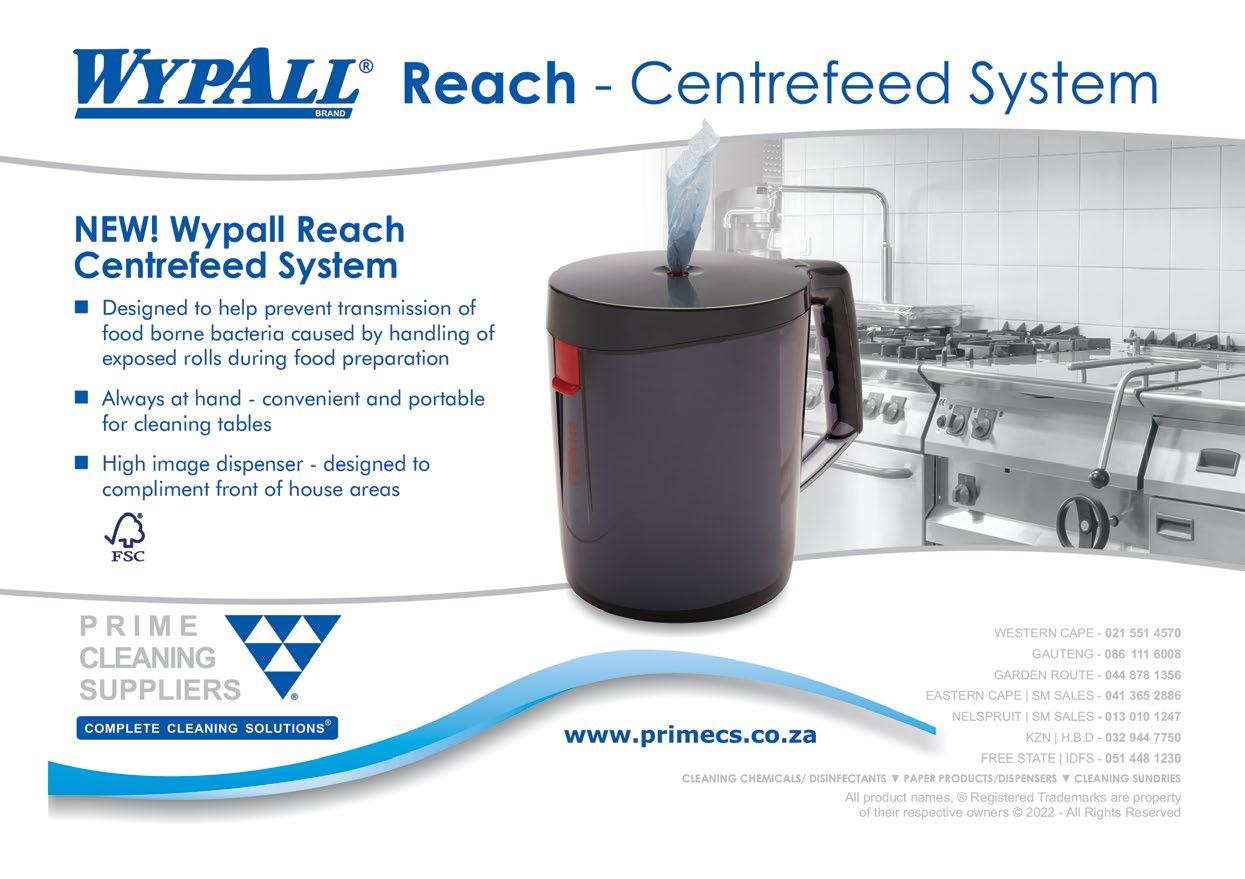
educational
continues
on page 31 >>
The future FM perspective
This thought-provoking article by John E. Kelley takes a closer look at the role of the facility service provider in the new normal. His 24 years’ experience in the US cleaning industry as senior vice president positions him perfectly to explore the role of the facility service provider going forward, in providing clients with a seamless, positive facility services experience.
Welcome to the new normal for facilities services. The COVID-19 pandemic has changed everything in the facilities industry: How we manage facilities, how we clean facilities, how we support our clients when their facilities are empty due to the pandemic, and how we are currently supporting our clients as their employees start to return to their offices. And, of course, each COVID-19 variant changes or resets the path back to BAU (business as usual).
What we know
We have seen the CDC (Centers for Disease Control and Prevention) and OSHA (Occupational Safety and Health Administration) provide
recommendations and requirements to help us return to BAU. We continue to receive regular information updates from these organisations about how COVID-19 spreads. And we also are getting updates from the U.S. Environmental Protection Agency (EPA) on approved disinfectant registration (List N).
All these agencies are supporting what we clean and disinfect, how we clean and disinfect, and when we should clean and disinfect, as well as recommendations and requirements for employee safety when providing these cleaning and disinfection services.
What is changing?
So, what is the BAU for facility service for the future? We believe that the facilities we manage and the clients we
serve today are rapidly changing the look, feel, features, and amenities in their spaces to draw in new talent and keep existing talent in place.
We also believe that the new office space will be different in design: more open, more inviting and more creative. The office of the future will be a destination.1 The days of cube farms with hundreds or even thousands of desks and limited meeting and huddle rooms will be replaced with large social spaces, collaboration spaces, conference rooms and training facilities.
Technology will also be a critical part of this transformed space, helping clients connect and collaborate globally with their teams and clients wherever they are. Desk space has become less critical in the overall requirements for

26 African Cleaning Review November/December 2022 facilities management review
the office of the future. When you need heads-down time to work on a project, you can do that from home, as the past two years have shown that employees can be efficient and productive while working remotely.
The office is and will always be the heartbeat of every organisation, but it no longer needs to be a place where every employee must come every day to be able to work. There are some exceptions to this redesign that removes individual or cubical office space, specifically in regions where housing is restrictive because of square meterage, family dynamics are multi-generational, or very young children are in the home.
So how do we, in the facility services industry, support our clients and their employees? In The Workplace You Need Now, the authors talk about the workplace of tomorrow needing to be a destination, a place where all employees want to come to collaborate, be creative, socialise, connect and receive guidance and inspiration from their peers, managers and leaders. This
new destination will have more social and connectivity features and fewer heads-down workstations.
We have seen that working from home is as productive as working from the office. So, turning the office of the future into a creativity zone to generate ideas, collaborate and find inspiration is what the future office will need to become. Organisations need to adopt new ‘activity-based workplace’ designed attributes, including free addressing, hot-desking and hotel-reservation desking solutions.
How do we help?
What is the role of the facility service provider? The new normal is that cleanliness and hygiene will be key to employees feeling safe in the built environments where they work, shop, dine and socialise, and an enhanced focus on air quality, health screenings, cleaning protocols and more are no longer optional. The facility services industry must embrace the technology that is available today – self-
cleaning surfaces, robotics, touchless consumable dispensers and contactless technology, and be vigilant about what is on the horizon that can improve or enhance facility services delivery.

In this competitive industry with increasing wages, an aging workforce, difficulty attracting young talent and clients needing to find ways to reduce costs or control cost increases, we must be looking for the next innovation or technology that will help us make positive change in the facility services industry.
We are looking for supplier partners that bring systems like performance management, health and safety verification, a positive customer service experience, and a sustainability programme to the table. We need supplier partners that are agile, transparent and leading edge in technology and innovation that are also willing to work within our systems and technologies to help us help our clients have a seamless, positive facility services experience.
management review
facilities
Hospitality industry laundry – win by optimising your processes

Industrial laundries are designed to work intensively for years, also taking into account water, detergent and energy consumption, spin power and other factors that contribute to efficiency, an essential feature that is critical for machines in this category. For this reason, it is imperative to define the different technical aspects and features that industrial washing machines need in order to be useful in fulfilling the function they are designed for. However, there is another aspect that should be considered, which is the classification of professional washing machines by industry. A washing machine for a vended laundry is not the same as one for a hospital, hotel or restaurant laundry, so each of them must be designed to meet the needs of every sector.
This abridged article by Girbau, a world leader in comprehensive

professional laundry and textile treatment solutions focuses on the hospitality industry to shed more light on what sets industrial washing machines for this industry sector apart – as impeccable towels, sheets, bedspreads and uniforms make all the difference to quality in a hotel or restaurant. The work performed in the laundry, sometimes so distant from guests, has a direct impact on the guests’ impression of their stay at the establishment. It is for this reason that so many businesses in this sector prefer to have their own laundry, to control and guarantee the quality of cleaning and disinfection of fabrics.
So, in this industry, restaurants and hoteliers are looking for versatile, longlasting machines that must of course deliver a top-quality wash while at the same time caring for the different types of fabrics, throughout the washing
process, to maintain their texture, colour and aroma, taking into account efficiency and sustainability, concepts that are very closely linked. In this respect, Girbau supplies a wash system specifically for hotels, which can provide up to 40 percent in savings. This solution is flexible and adapts to the volume of throughput in each establishment to ensure maximum profitability.
Another aspect rated highly by hoteliers when choosing machines is connectivity features, thanks to solutions that allow the laundry to be controlled remotely – like Sapphire, the Girbau smart remote control software for laundry management that delivers a massive improvement in the way a laundry is operated and cuts down time and costs.
Finally, because of the COVID-19 pandemic, disinfection has taken on special importance to ensure people’s
laundry
review
safety and health, even more so in hotels, restaurants and other leisure establishments. It should also be borne in mind that industrial washing machines for the hospitality industry can have tools to guarantee hygiene and disinfection in laundries, like the Disinfection Monitoring Package (DMP), the pioneering solution from Girbau designed specifically to respond to a pandemic scenario and viruses or bacteria of all kinds.
One of the principles in achieving a better world is to respect it, and this is
why savings and sustainability play a fundamental role, both to protect the planet and to save money and ensure the viability of any business. For this reason the new Girbau Genius range of washing machines is designed to be perfectly suited to the hospitality industry, taking into account each and every one of the sector’s needs and challenges and always placing sustainability and energy saving centre stage through the latest novelties and solutions in this field to pollute less and to ensure lower CO2 emissions.
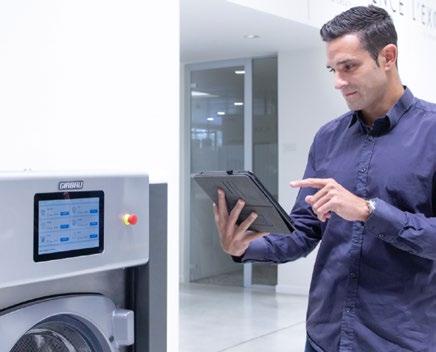
Textile service industry digitalisation showcased
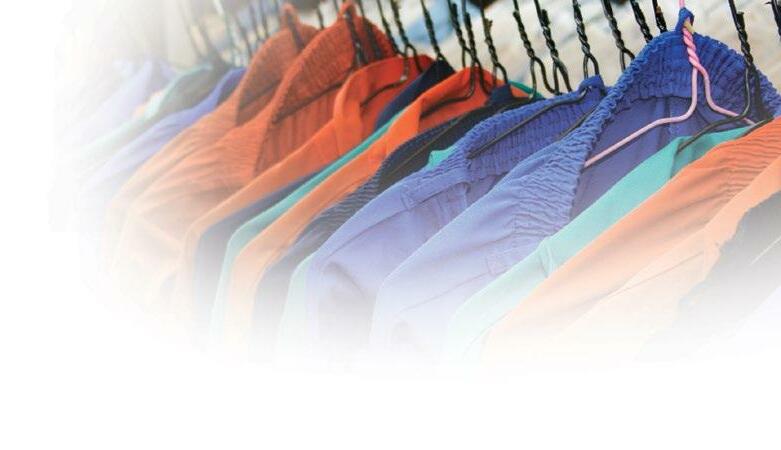
At the recent EXPOdetergo International held during October in Milan, Italy, the software specialist for the textile service industry SoCom presented itself to international trade by showcasing the complete TIKOS product range, including all app and web solutions.

The dominant theme of SoCom’s trade fair presentation was digitalisation. Digital order management, paperless order picking, an efficient and thoroughly future-proof logistics concept for which the software service provider has developed suitable solutions to create a digital and paperless laundry operation.
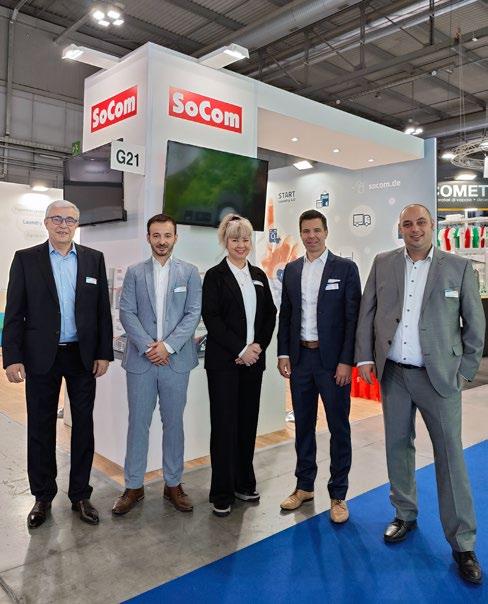
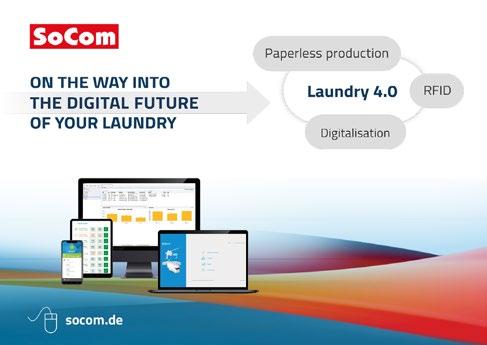
Transparency and well-coordinated processes are now more important than ever in a time with high dynamics of change and constantly shifting external influences and are the focus of the development of all products for future-oriented concepts of digital and paperless production.
“Both the development of new app and web solutions and the ongoing development of the ERP solution, TIKOS, are about digitalising all business transactions in a laundry step by step and thereby creating transparency. The goal is to optimally and resource-efficiently control processes and the associated logistics using modern software products. As a result, customers can be served individually, according to their needs and on time,” says SoCom CEO Wolfgang Faist.
For more information, visit: www.socom.de/en
29 African Cleaning Review November/December 2022
laundry
review
Team SoCom pictured at EXPOdetergo 2022
people and events
Goscor Cleaning Equipment celebrates opening of new premises in Johannesburg





Goscor Cleaning Equipment (GCE) celebrated the opening of its new premises in Johannesburg during October with an aptly named Gostoberfest. GCE Managing Director Greg Venter welcomed guests and clients to the new facility and expressed his excitement with the ample possibilities that the new premises offer. He also announced new developments including GCE’s full partnership with High Point Vacuum, leaders in industrial vacuum applications and the new IPC cleaning equipment range, which the company is now able to offer to clients.
“With the move to a new facility, new quality IPC product range and High Point Vacuum partnership, we are incredibly excited about the future and possibilities for growth in the business. Without our customers’ support we would not have reached this point – thank you very much”, says Venter.
30 African Cleaning Review November/December 2022
German Oompah band, The Eishbeins, provided the afternoon’s entertainment
GCE staff welcomed guests and clients to the Gostoberfest
Greg Venter
High Point Vacuum truck
1. Cleaning floors
Clean floors give a great (first) impression. But more importantly, clean floors improve the safety of people as it prevents slip-and-fall hazards. Traffic density can lead to germs spreading all over your floors, which subsequently leads to the spread of illnesses and diseases. By cleaning your floors properly and regularly, you can ensure a fresh, healthy and clean environment.
2. Cleaning walls and ceilings
Ceilings and walls are exposed to all sorts of dirt and dust, spider webs, and in certain environments even pet dander, cooking oils, grease, cigarette smoke and more. As walls and ceilings can be difficult to access, they are often easily overlooked or even skipped altogether. As ceilings and walls can get really dirty they should always be taken into account. Especially as air-conditioning or
certain ventilation could spread the dirt throughout your space. Walls and ceilings call for smart cleaning solutions.
3. Cleaning furniture and surfaces
Surface cleaning is another important dimension of cleaning. Whether cleaning in sports stadiums, cinemas, schools, or retail facilities, there are a lot of surfaces to be cleaned. Nowadays we must be aware of important (and unnoticed) touchpoints: areas that are often touched by people as they go throughout their days (think of desks, phones, computer mouse, and more obvious: the toilet flush button). These touch points are an extra risk when it comes to spreading germs. It’s important to not only clean, but also disinfect furniture and surfaces.
4. Cleaning indoor air
Indoor air quality can be up to 5-10 times worse than outdoor air quality. Not something to take
lightly, considering that we spend an average of 90 percent of our time indoors. Poor indoor air quality can result in headaches, fatigue, allergic reactions, asthma attacks and virus transmission. Ventilation is known as an efficient way to provide clean air. But ventilation alone is not enough. Besides the fact that it boosts your energy bill during colder days, it doesn’t filter aerosols out of the air. In other words: germs can still spread. But there’s a solution. Air purification does filter aerosols out of the air, resulting in a perfectly clean, healthy, and fresh indoor environment.
Article by i-team Global, a company that focuses on the development and design of high-end cleaning machines, products and utilities. For more information and cleaning recommendations visit: www.i-teamglobal.com
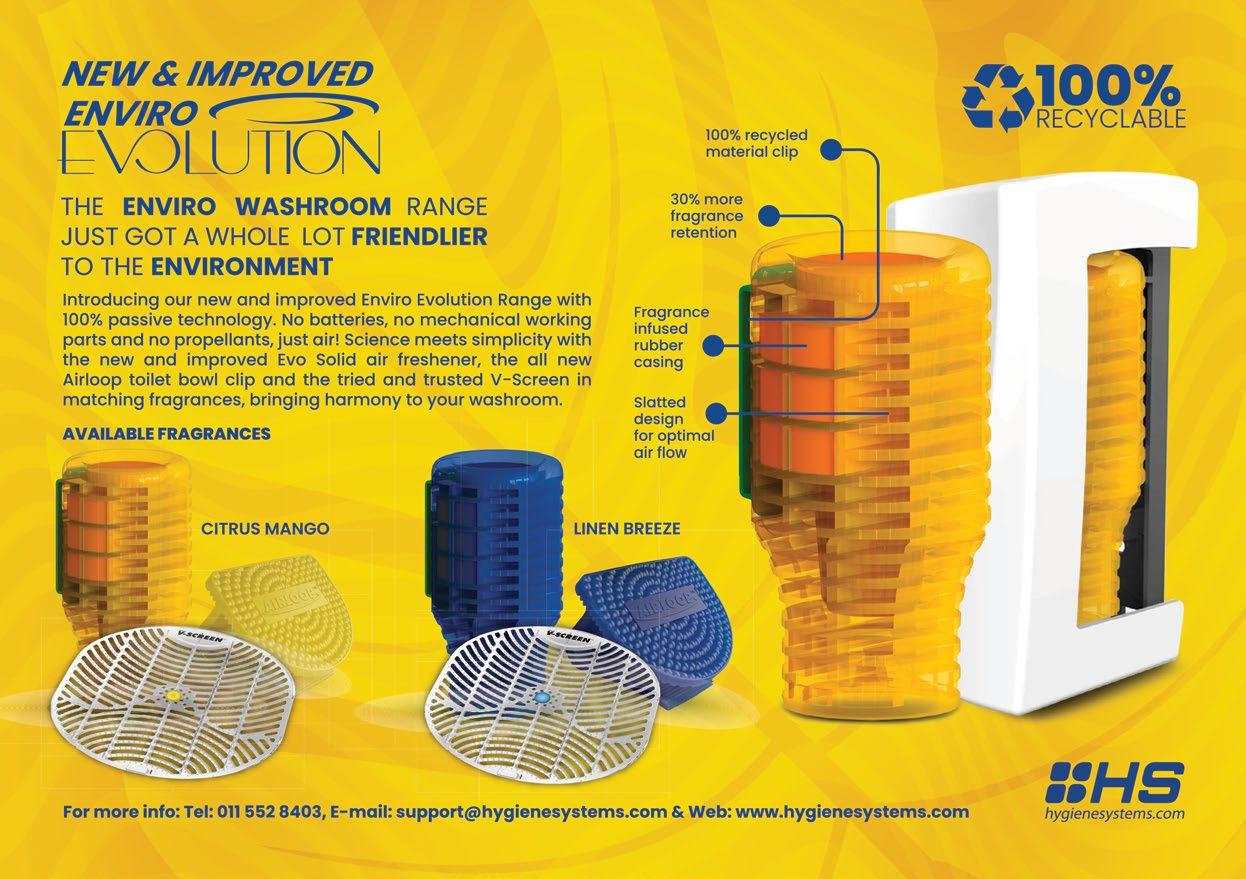
educational << continues from page 25
Innovative and professional orbital single-disc machine
At the recent Cleantex Africa exhibition, CleanSol launched Ghibli’s O 143 Spray, a professional and innovative orbital single-disc machine specifically designed to clean delicate surfaces such as fitted carpets. The oscillating head adapts to all surfaces and allows for the removal of dirt particles from the fibres and guarantees reduced drying time. The spray system with a CEME pump and two adjustable nozzles on standard equipment allows for perfect working-area coverage.
This machine utilises the latest oscillating technology and forms part of CleanSol’s drive for ‘greener’ cleaning that reduces the carbon footprint. In a water-scarce country like South Africa, this machine is unique in that it utilises
very little water to deliver a better result than traditional cleaning methods. In addition to carpet cleaning, it is especially effective in dry stripping of floors and cleaning porcelain tiles. Traditional tasks like stripping of vinyl floors can now be performed during normal working hours, thereby reducing overtime and without the use of chemicals.
The Ghibli Orbital O 143 Spray also overcomes the problem of residue when cleaning porcelain floors. If you ever had a problem with track or streak marks or the discolouring of porcelain floors, this machine is the answer. Also,
Eradicating single-use plastics
‘The reduction of single-use plastics’ is the latest buzz phrase on everyone’s lips. According to an article in National Geographic, “the amount of plastic trash that flows into our oceans every year is expected to triple by 2040 to 29 million metric tons”. Mindful of this, Hygiene Systems explored options to provide solutions in reducing and, where possible, eliminating single-use plastics in their products.
For instance, the aerosol fragrance dispenser in a washroom requires a new refill every month or at least every second month. Each one of these refill cans has a plastic dust cap that is only ever used once in transport and then disposed of. Hygiene Systems has replaced this plastic dust cap with a new biodegradable EcoCap™.
scrubbing of stubborn dirt on cement, paving or parking areas can now be performed problem free.
Features:
• Ergonomic handle and compact frame
• Spray system with 12L tank, CEME pump and adjustable nozzles
• Brush-head locking system
• Working width – 430mm
• Large wheels and reduced weight facilitates ease of use
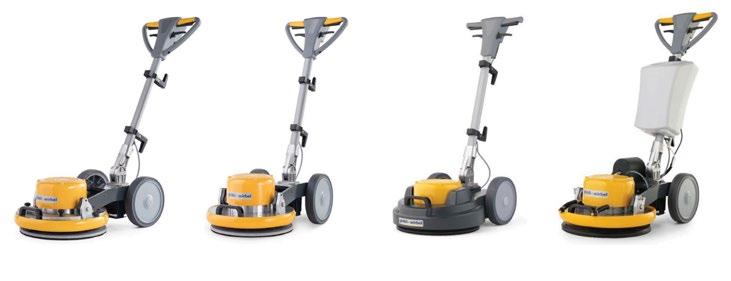


For more information, email CleanSol Supplies on info@cleansol.co.za or visit: www.cleansol.co.za

EcoCap™ is an engineered cardboard cover that fits perfectly onto Airmist™ cans, protecting the valve during packaging and the transport process. Manufactured from 100 percent biodegradable material, it can be disposed of knowing that it’s one less piece of single-use plastic entering our already fragile environment.
In addition to doing away with the plastic dust cap, the company also replaced the plastic outer packaging with a cardboard version. The combination of these two initiatives represents the equivalent of 7 tons of single-use plastic that won’t be entering our fragile environment every year.
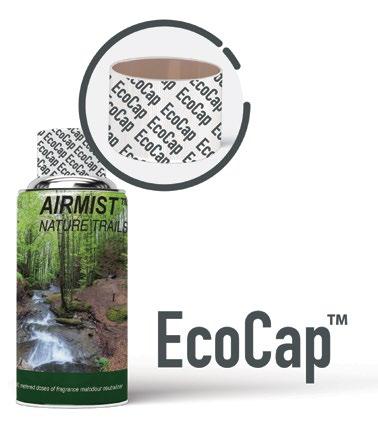
32 African Cleaning Review November/December 2022 new products
For more information regarding advertising / editorial / digital packages, email: nande@cleantex.co.za www.africancleaningreview.co.za Advertise in the primary African trade magazine for the commercial cleaning and hygiene sectors. Reach your target market cost-effectively with a direct link to end-users, building service contractors, facility management and key institutional segments.
KCP launches 100% bio-based and recyclable core plug
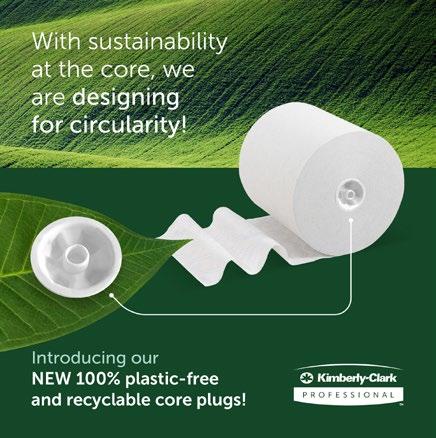
Kimberly-Clark Professional (KCP) has introduced 100 percent bio-based and recyclable core plugs in its Scott and Kleenex hand towel ranges across Europe, the Middle East and Africa. The plastic-free core plugs are made primarily from starch and fibre, replacing plastic core plugs currently in use. It is estimated to reduce plastic by over 30 tons every year – the equivalent weight of 1.5 million plastic bottles.
As with all of Kimberly-Clark Professional’s washroom and wiper products and services, this product innovation is designed to help cleaning professionals improve efficiency and recycling rates while simplifying the waste-management process.
When replacing the hand-towel roll, cleaning professionals typically separate the card-based hand-towel roll from the plastic core plug for their different disposal or recycling streams. With this new plastic-free core plug, there is no need to spend time separating
the waste into paper and plastic, as the towel roll and plug can be disposed of together in paper recycling streams.
“I am proud that we are designing innovative products with circularity in mind and taking this step to eliminate unnecessary plastic in our hand-towel range with this gamechanging solution,” says Olena Neznal, vice president for Kimberly-Clark Professional in Europe, the Middle East and Africa. “In doing so, we are reducing plastic waste, helping our customers improve their recycling rates and saving cleaning professionals’ time.”
The manufacturer is launching this product innovation in Europe, the Middle East and Africa and will evaluate expansion into other markets as part of its global 2030 sustainability goals. The manufacturer has set a goal to reduce its plastic footprint by 50 percent by 2030 by using less virgin, fossil-fuel-based plastic and more
recycled, renewable or degradable materials while finding ways to support the transition to a circular economy. This contributes to the company’s global ambition to improve the lives of one billion people in underserved communities around the globe by 2030 with the smallest environmental footprint.
Professional vacuum cleaning robot with fleet management
The Cleanfix S170 Navi is a unique vacuum cleaning robot concept specially developed for professional use on hard floors and short pile carpets covering areas up to 300m2/per unit. It revolutionises professional floor cleaning in large office buildings, the hotel industry, care facilities, cruise ships and many more.
Specially built for use on single small- to medium-sized surfaces and thanks to the docking station with replaceable dust bags, even for long periods of time without human intervention, the S170 Navi cleans on-demand or on schedule, 24/7 and completely autonomously.
It cleans independently according to a systematic algorithm (no random cleaning) and intelligently adapts to changes and its environment. The docking station charges the battery and automatically empties the dust tank. Once charging/ dust emptying is completed, the robot continues cleaning from the previous position.
The docking station with suction function renders daily dust tank emptying obsolete, which significantly reduces the workload. The roller brush with rubber blades and brushes assists in collecting deep-seated dirt. The built-in HEPA filter and regular vacuuming reduce dust pollution in facilities and thus increase the well-being of employees and customers.
Features:
• Powerful 5’200 mAh battery with up to 250 minutes battery life
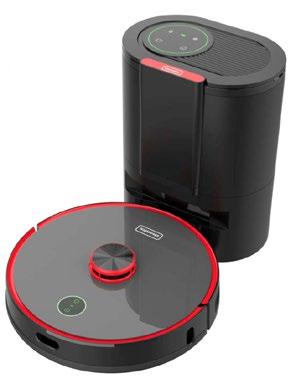
• Built for fleet use – the world’s first vacuum cleaning robot with fleet management, especially for professional use
• Laser – accurate navigation 9no camera) with automatic mapping, virtual walls, no-go areas and laser navigation (LiDAR)
The Cleanfix S170 Navi is distributed by Safic, for more information visit: www.safic.co.za
33 African Cleaning Review November/December 2022
new products










































































































































































































































